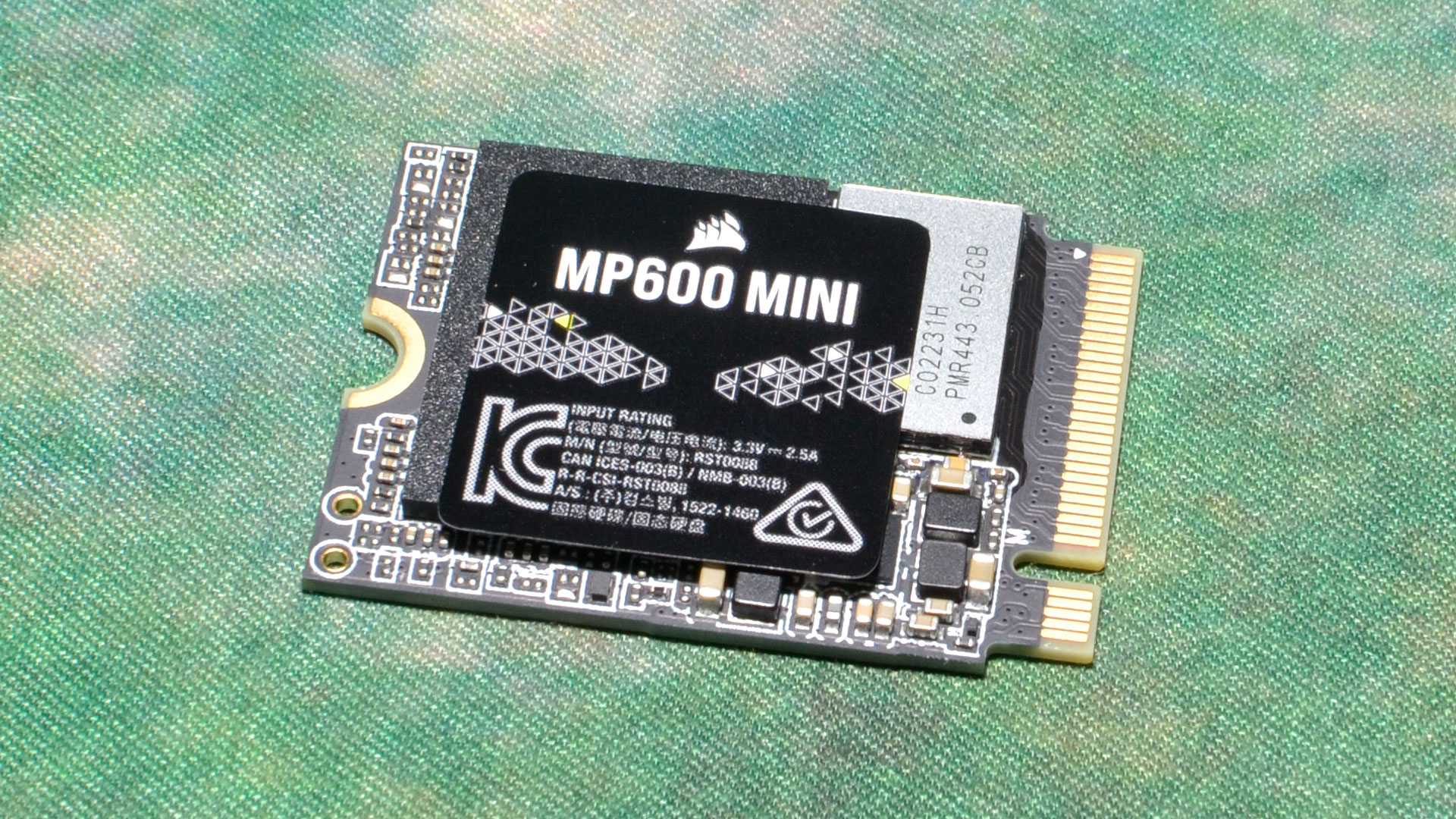Why you can trust Tom's Hardware
Comparison Products
The Corsair MP600 Mini is up against other M.2 2230 SSDs that we have tested, including the similar Rocket 2230, the Addlink S91, the older Inland TN436, the newer Inland TN446, and the Sabrent Rocket Q4 2230. This covers the most current and relevant retail options, with the Team MP44S on the way. The WD SN740, not compared, should be treated as a WD Black SN770. The Micron 2400, for its part, is similar to the Crucial P3 Plus but with an SMI controller. These two drives will be referred to where applicable but are not explicitly reviewed as they are built for OEMs.
Steam Deck Benchmarks - General
To gauge general Steam Deck performance, we engage in a variety of typical storage situations with active time measurement. These activities include dealing with the default SteamOS through initial setup, re-imaging, initial booting, and booting in general. For game testing, we see how long it takes to install and boot the popular title Hollow Knight. For a full explanation of our testing procedure, see our Steam Deck storage testing article.
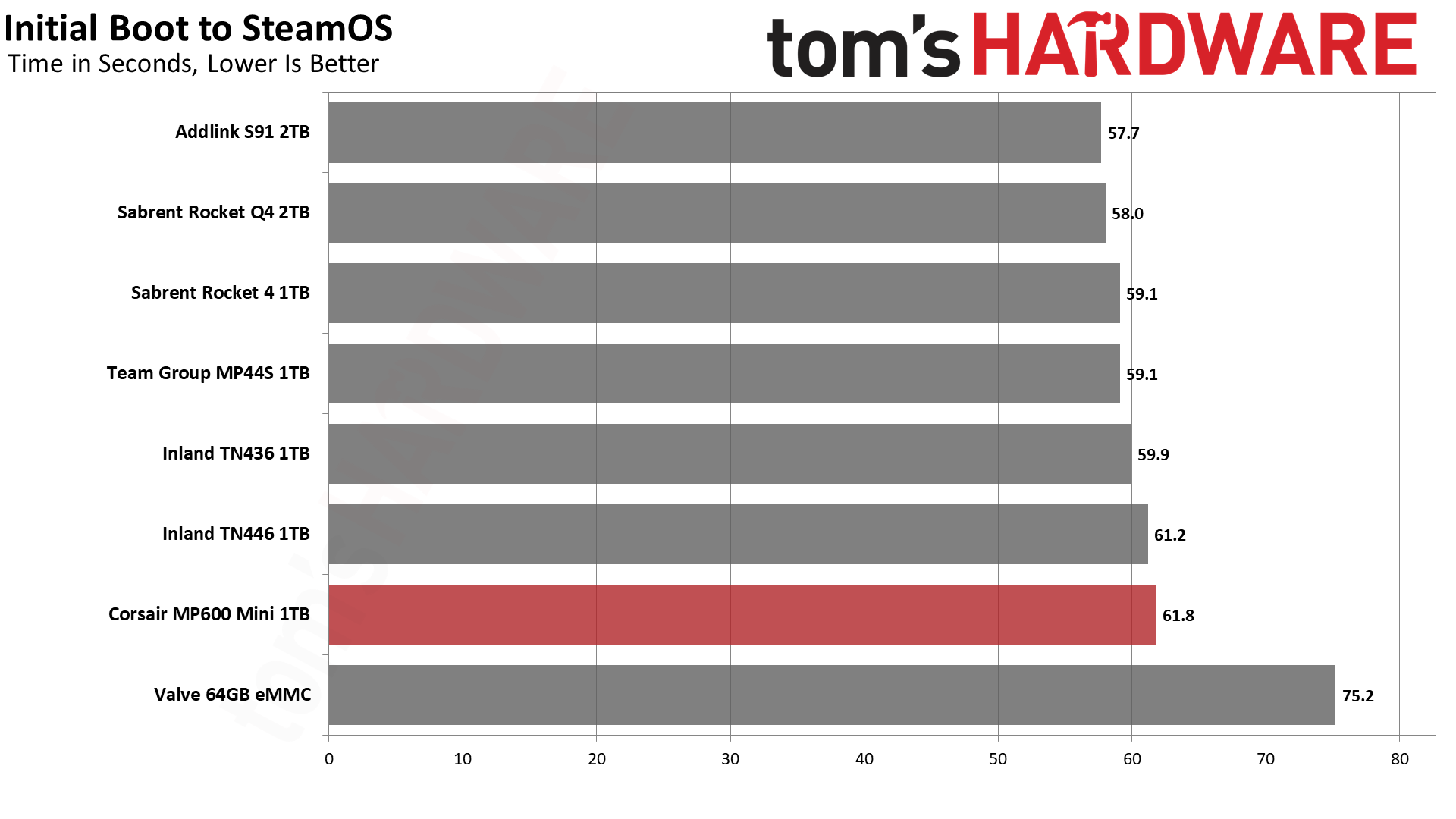

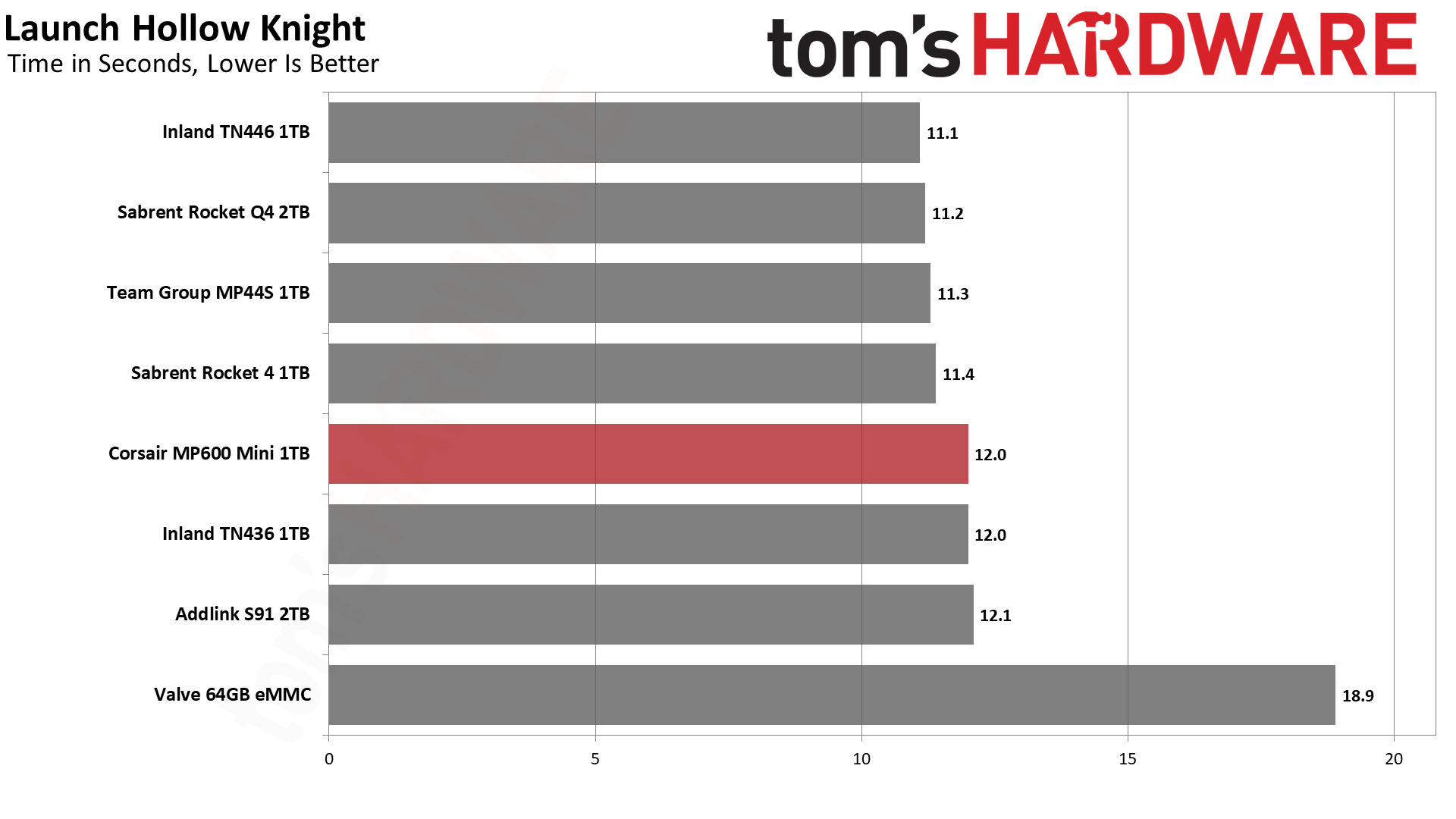
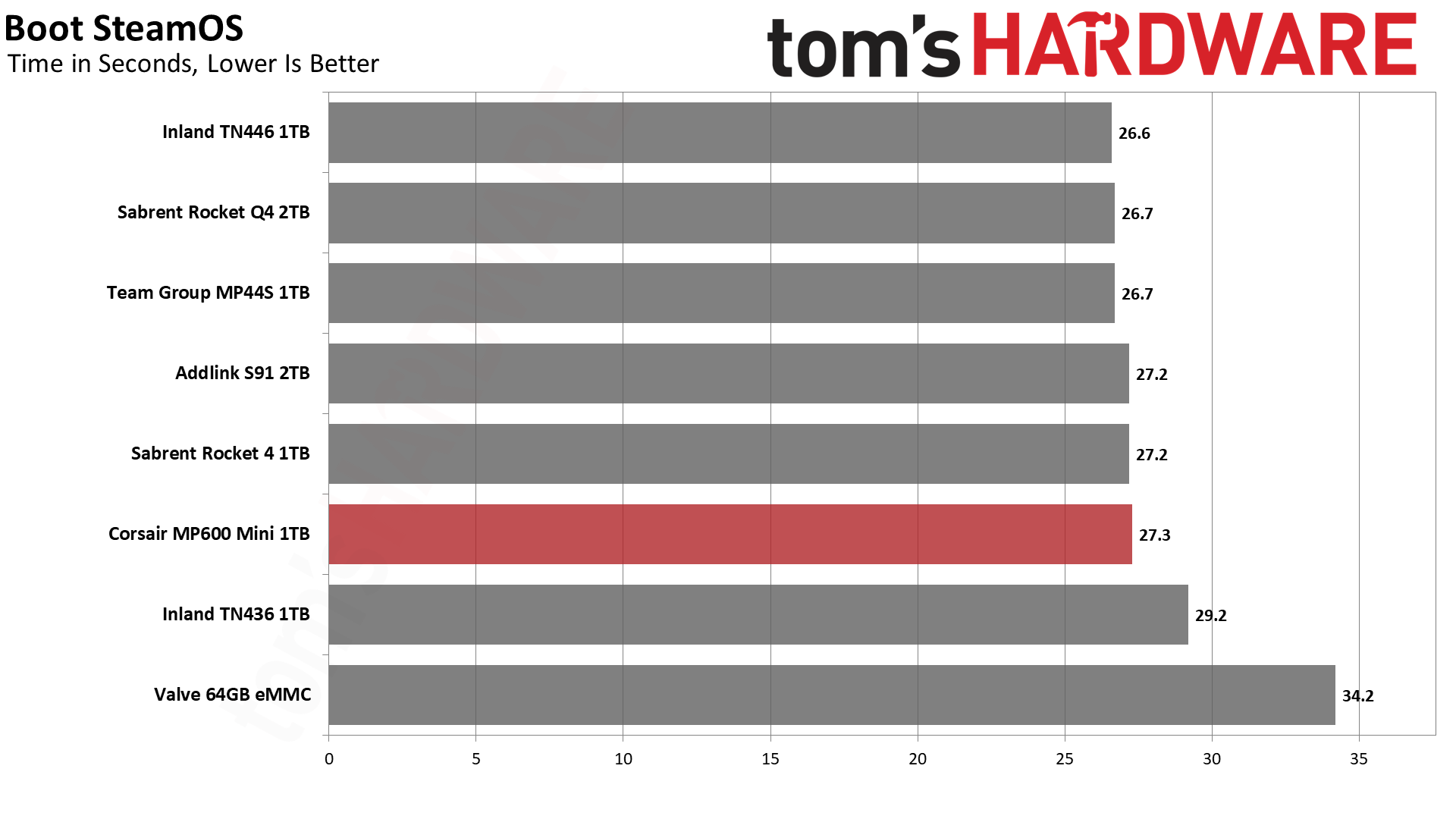
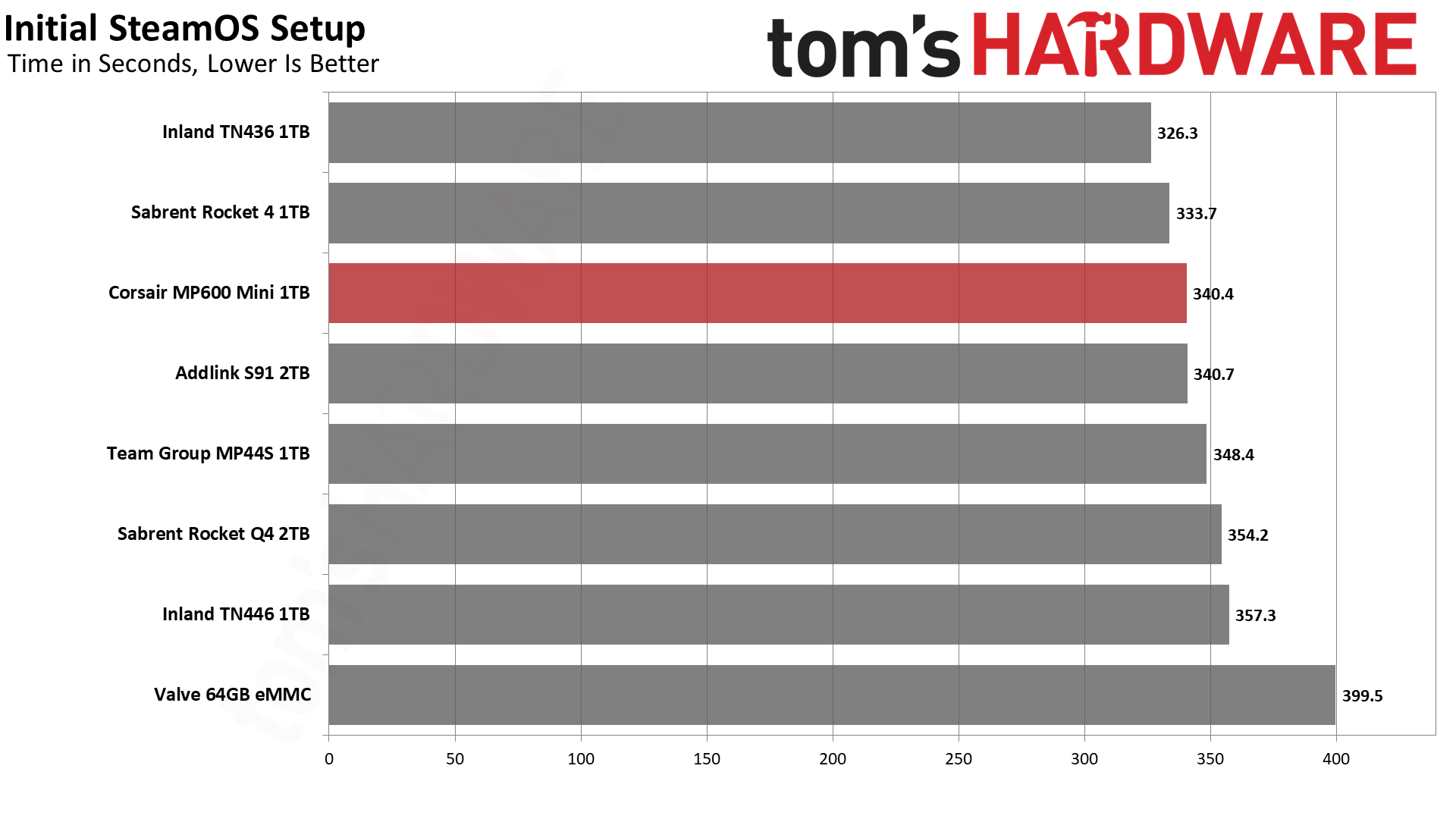

The MP600 Mini performs within the expected envelope, although, on the whole, it’s not quite as fast as the Rocket 2230. You would be excused for thinking there’s not much point in getting worked up over a second or two here and there. These tests do show a significant improvement over the stock 64GB drive, which is to be expected. The stock 256GB and 512GB drives would also be somewhat slower than our tested drives, but you won't notice in normal operation if you’re not checking a stopwatch.
However, after some writes and wear, performance over time could be different, especially with a fuller drive. It’s also worth considering efficiency as a newer drive like the MP600 Mini may pull less power over the device's lifetime, which could impact battery wear and lifespan. If you’re the type to reinstall the OS twenty times, multi-boot Windows, and engage in other experiments, there’s value in getting a high-performance SSD with TLC.
Steam Deck Benchmarks - KDiskMark and Temperature
One of the most popular, if not the most popular, storage benchmarks is CrysalDiskMark (CDM), which we use in our Windows-based SSD testing suite. This benchmark relies on Microsoft’s DiskSpd with templated test settings. CDM lets you quickly see how a drive performs against its idealized, rated specifications, and the benchmark can also hint at a more “real world” feel with low queue depth I/O testing.
The Linux flavor of this benchmark, which is easy to install on the Steam Deck, is KDiskMark. The “K” refers to the KDE desktop environment used on the Deck. KDiskMark relies on the Flexible I/O tester, or FIO, instead of DiskSpd. For the temperature portion, we use data from the SMART sensors on the drive, which can be directly polled and from which the maximum temperature can be extracted.
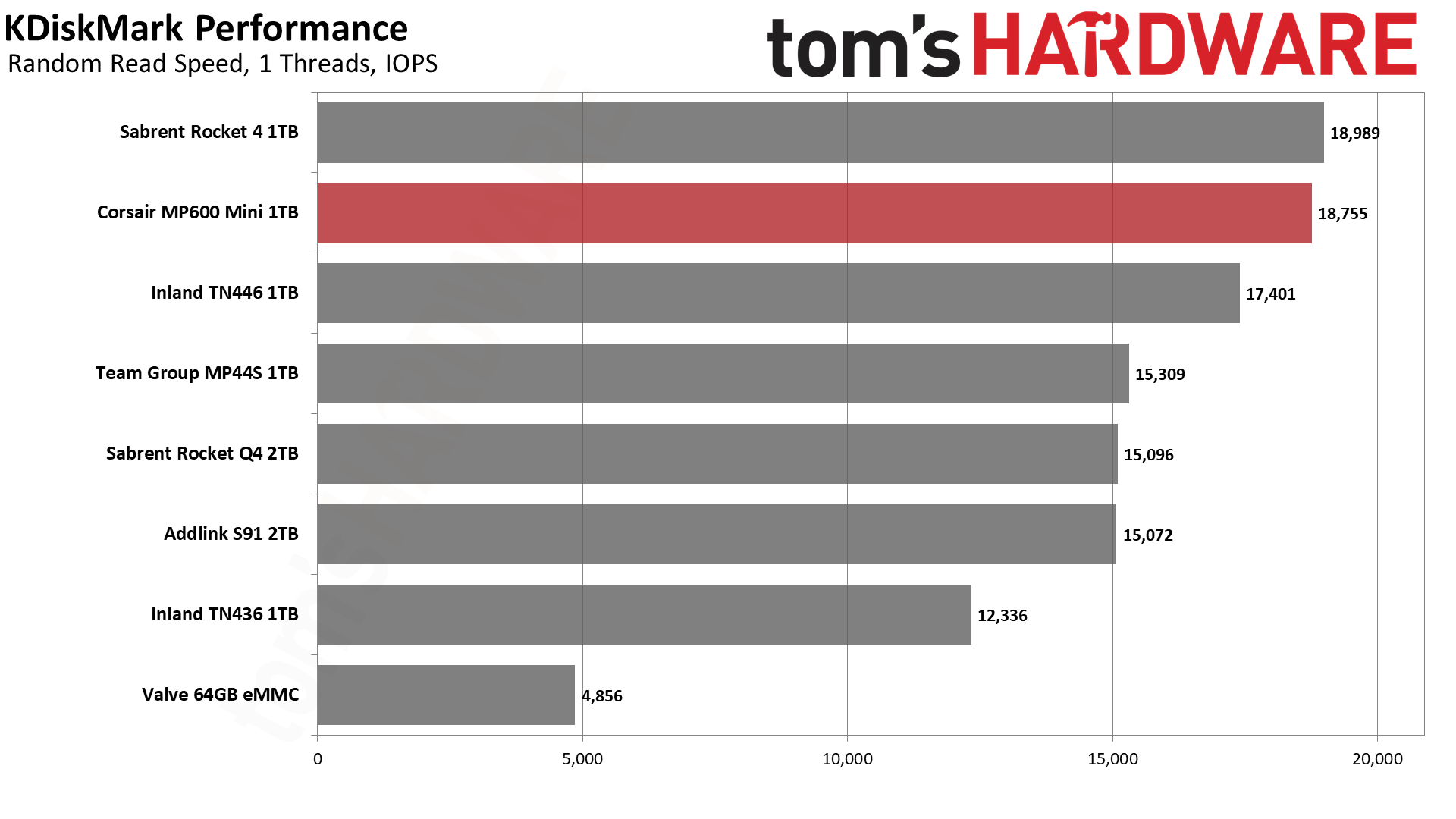
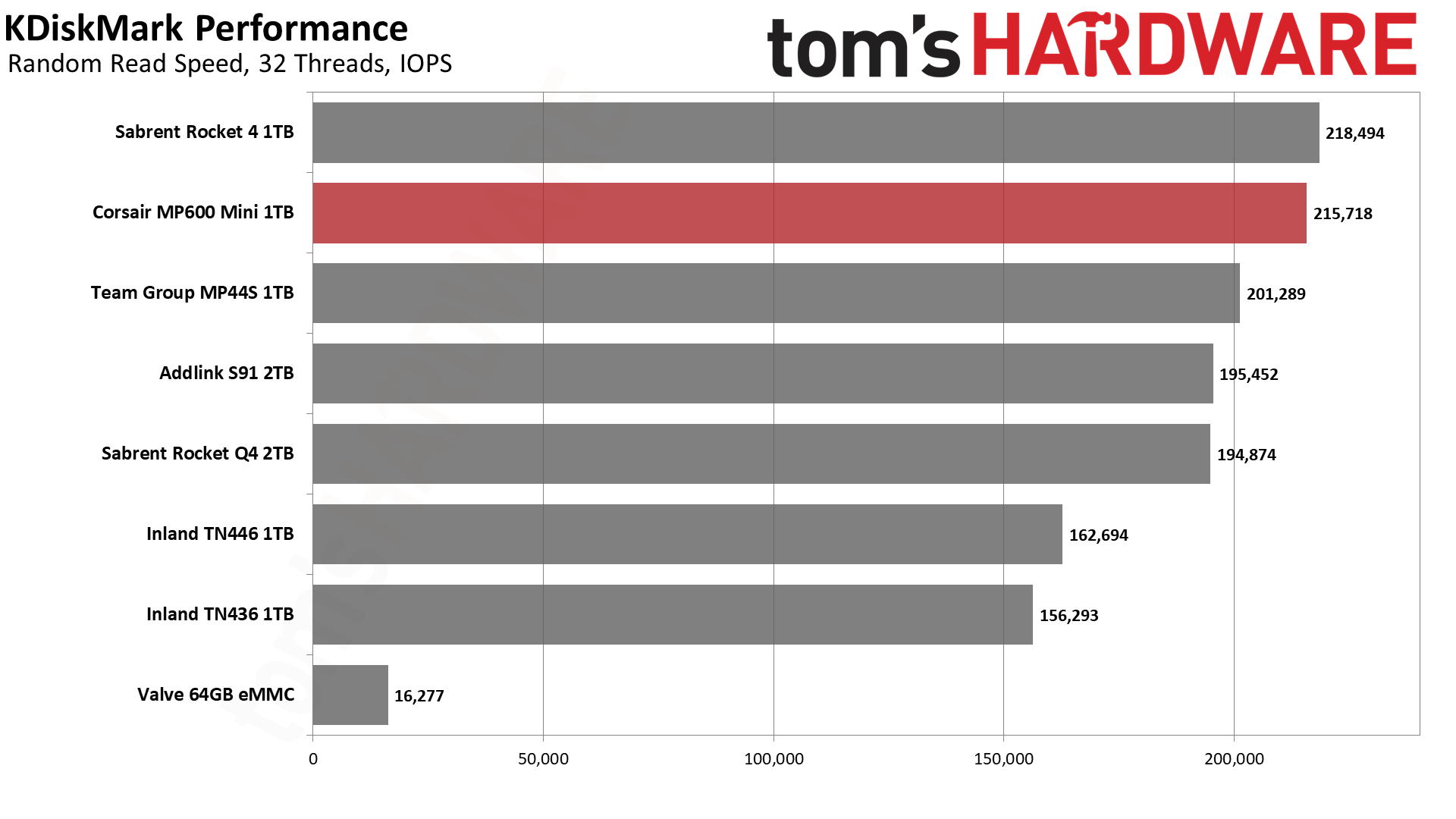
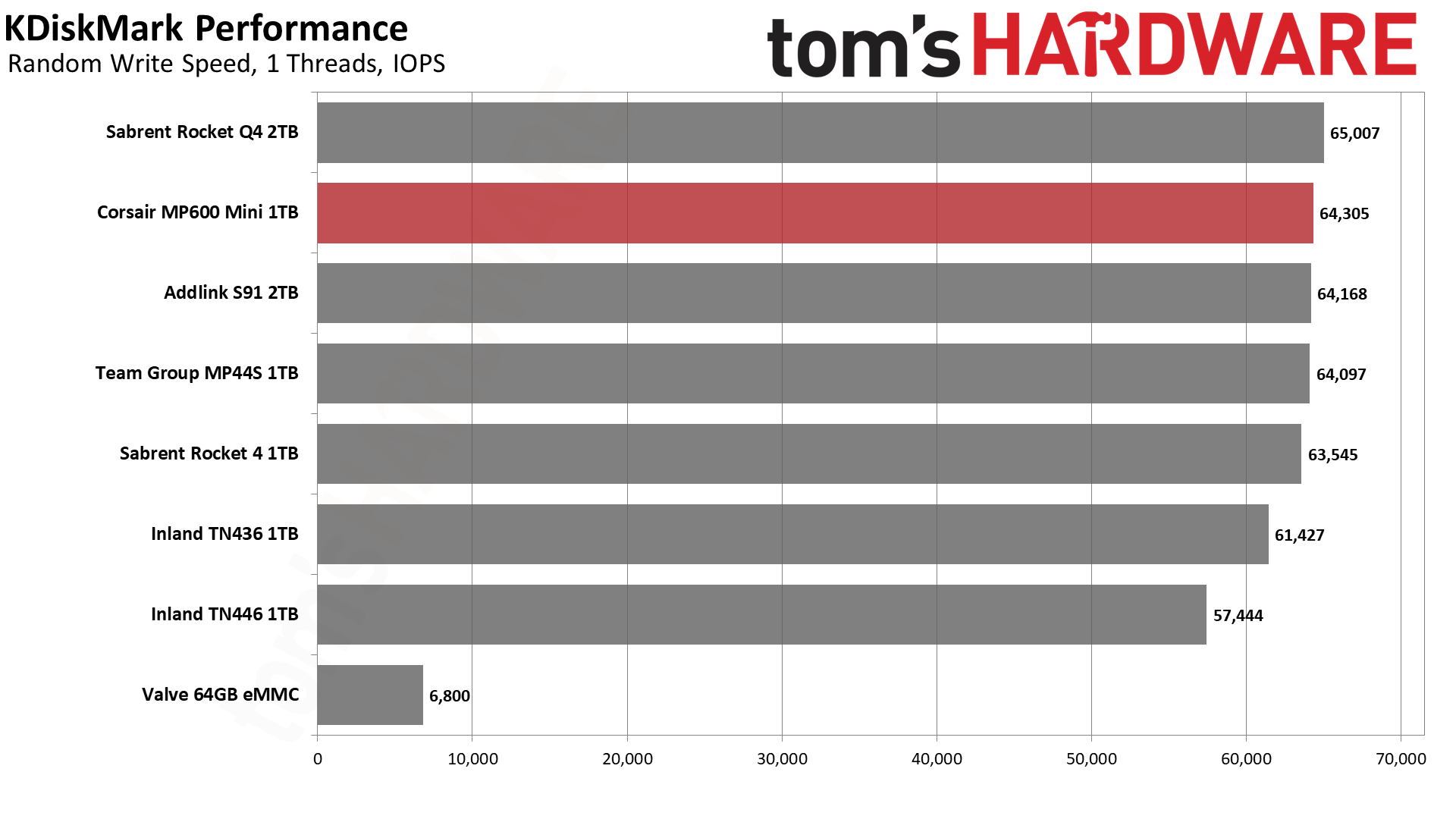





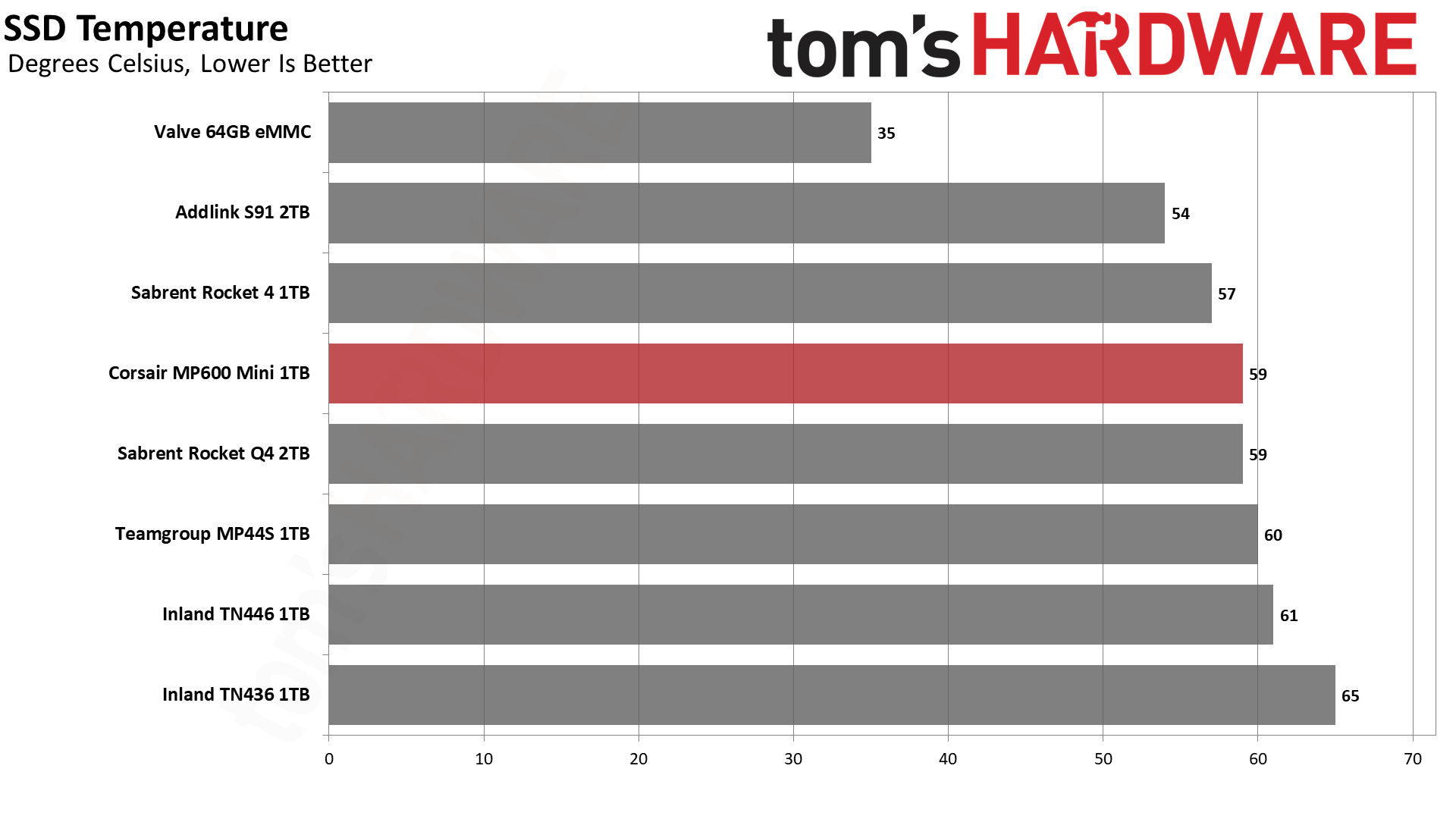
The MP600 Mini’s KDiskMark performance is adequate to good. Read performance at low queue depth remains an important result, whether sequential or random, as it correlates with “real world” feel, which includes game and app loading times to a smaller degree. This is more noticeable in some cases than others, although the difference suggested here is not huge. It’s worth upgrading from the stock drive for both performance and capacity, but it might not be worth upgrading from the TN436 for performance alone if you happen to already have one - depending on how you use your Deck.
Get Tom's Hardware's best news and in-depth reviews, straight to your inbox.
The MP600 Mini’s temperature is within reason, coming in six degrees cooler than the TN436. It runs a lot hotter than the stock drive, but that makes sense, given the limited capacity and performance of the 64GB eMMC original.
PC Trace Testing - 3DMark Gaming Storage Benchmark
Built for gamers, 3DMark’s Storage Benchmark focuses on real-world gaming performance. Each round in this benchmark stresses storage based on gaming activities including loading games, saving progress, installing game files, and recording gameplay video streams.

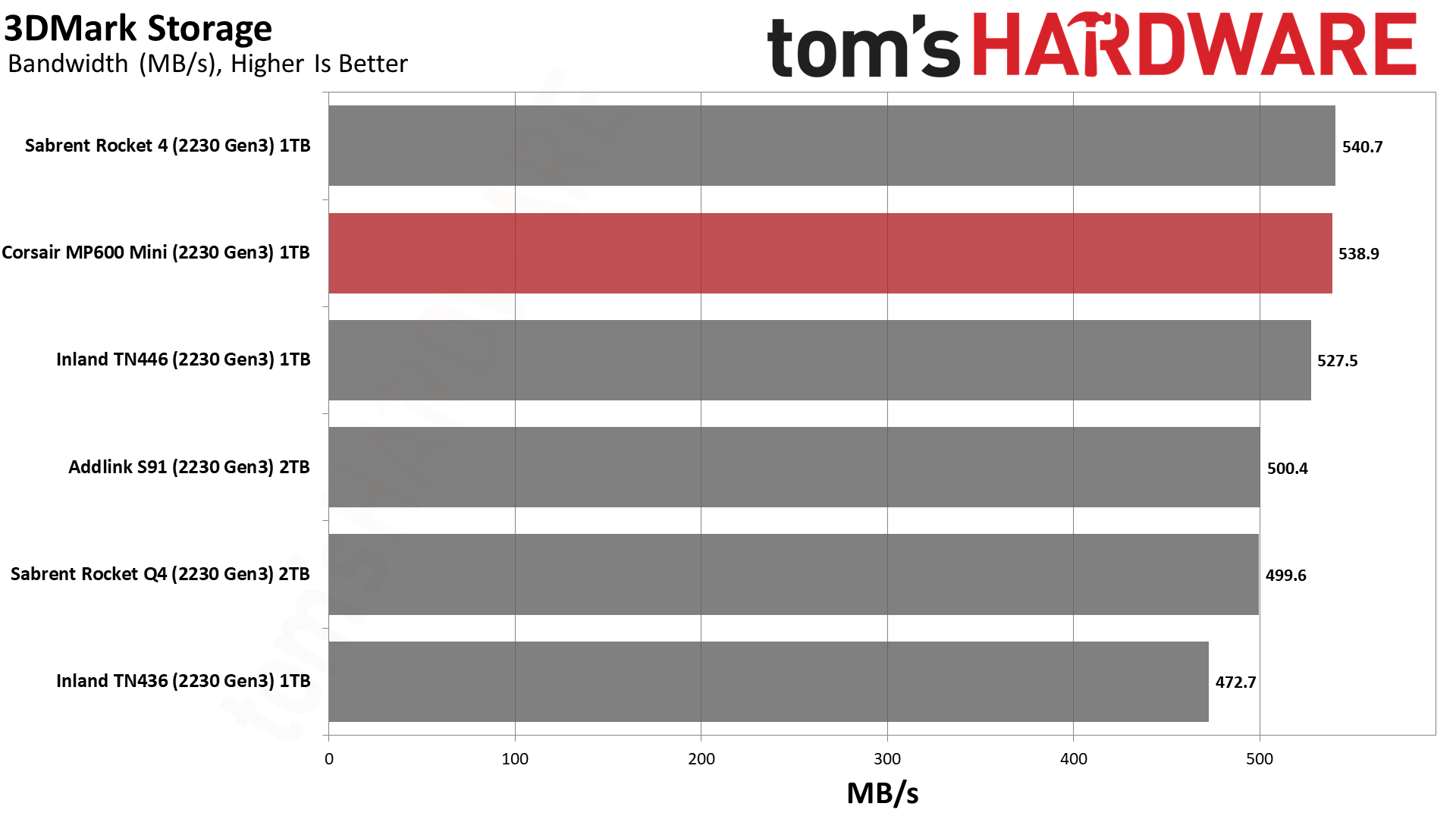

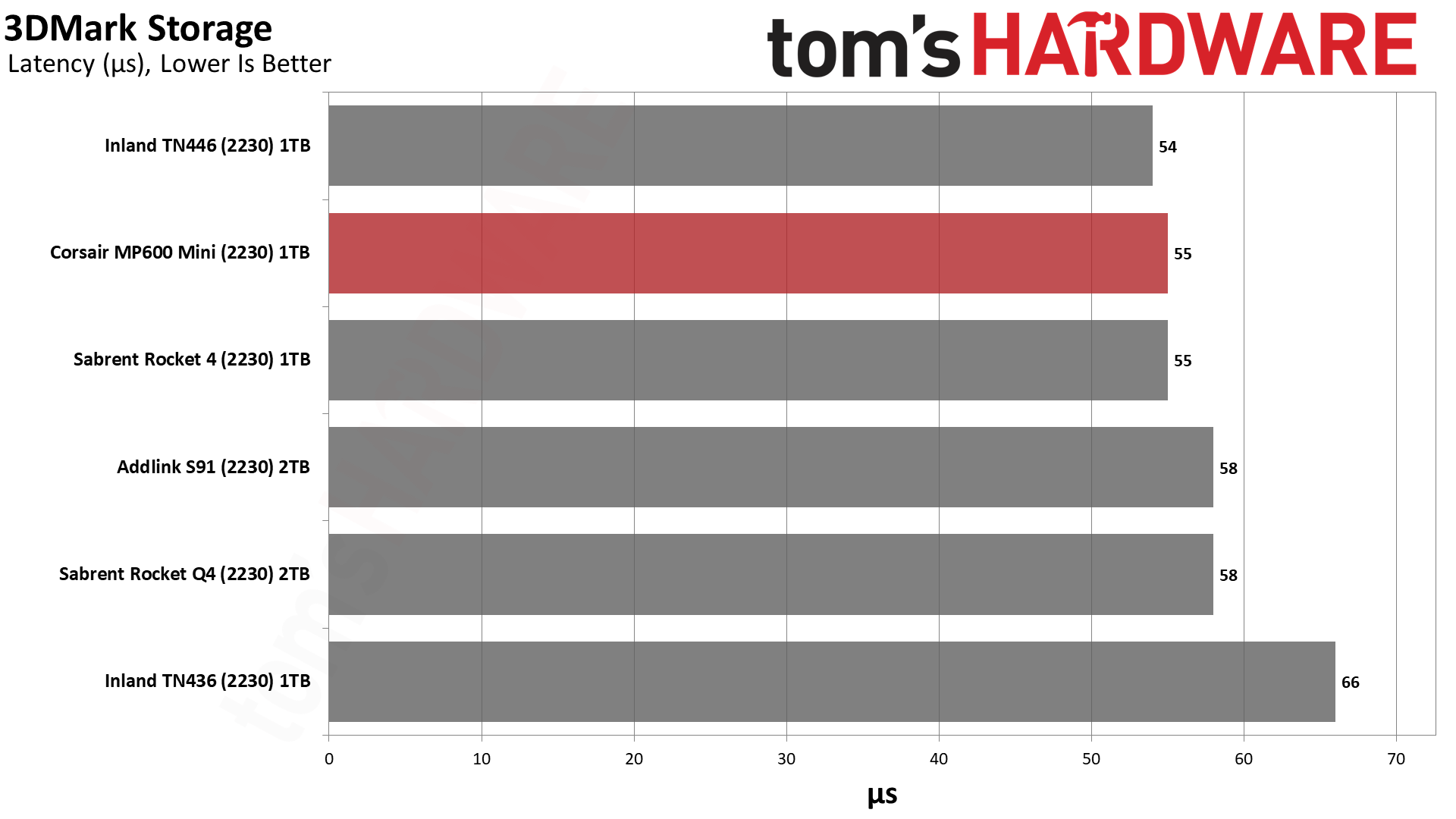


The MP600 Mini comes out near the top, matching the TN446 and Rocket 2230. It performs better than the QLC-based S91 and Rocket Q4 2230 and much better than the older TN436. Latency is somewhat improved in PCIe 4.0 mode.
PC Trace Testing – PCMark 10 Storage Benchmark
PCMark 10 is a trace-based benchmark that uses a wide-ranging set of real-world traces from popular applications and everyday tasks to measure the performance of storage devices.

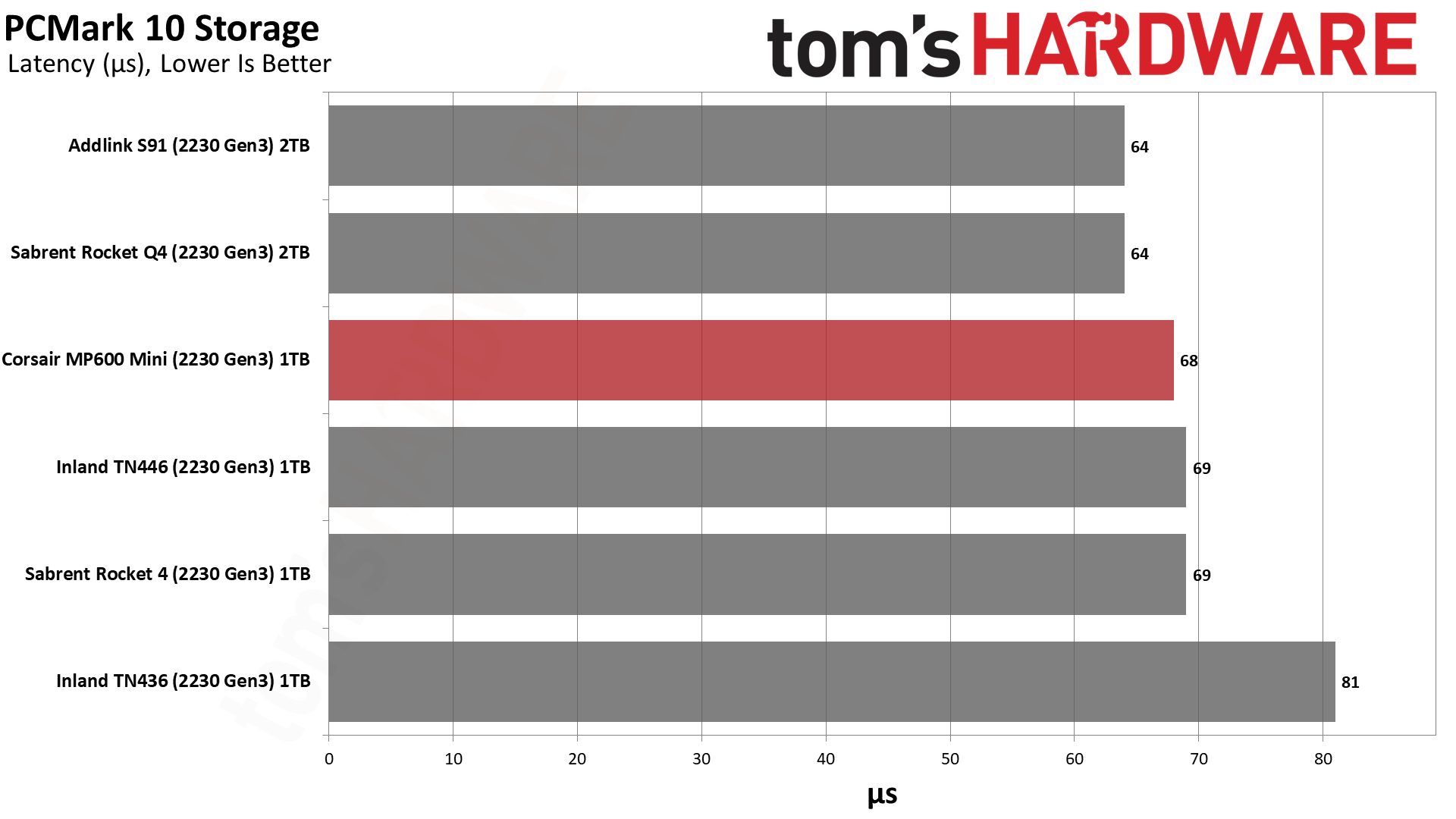
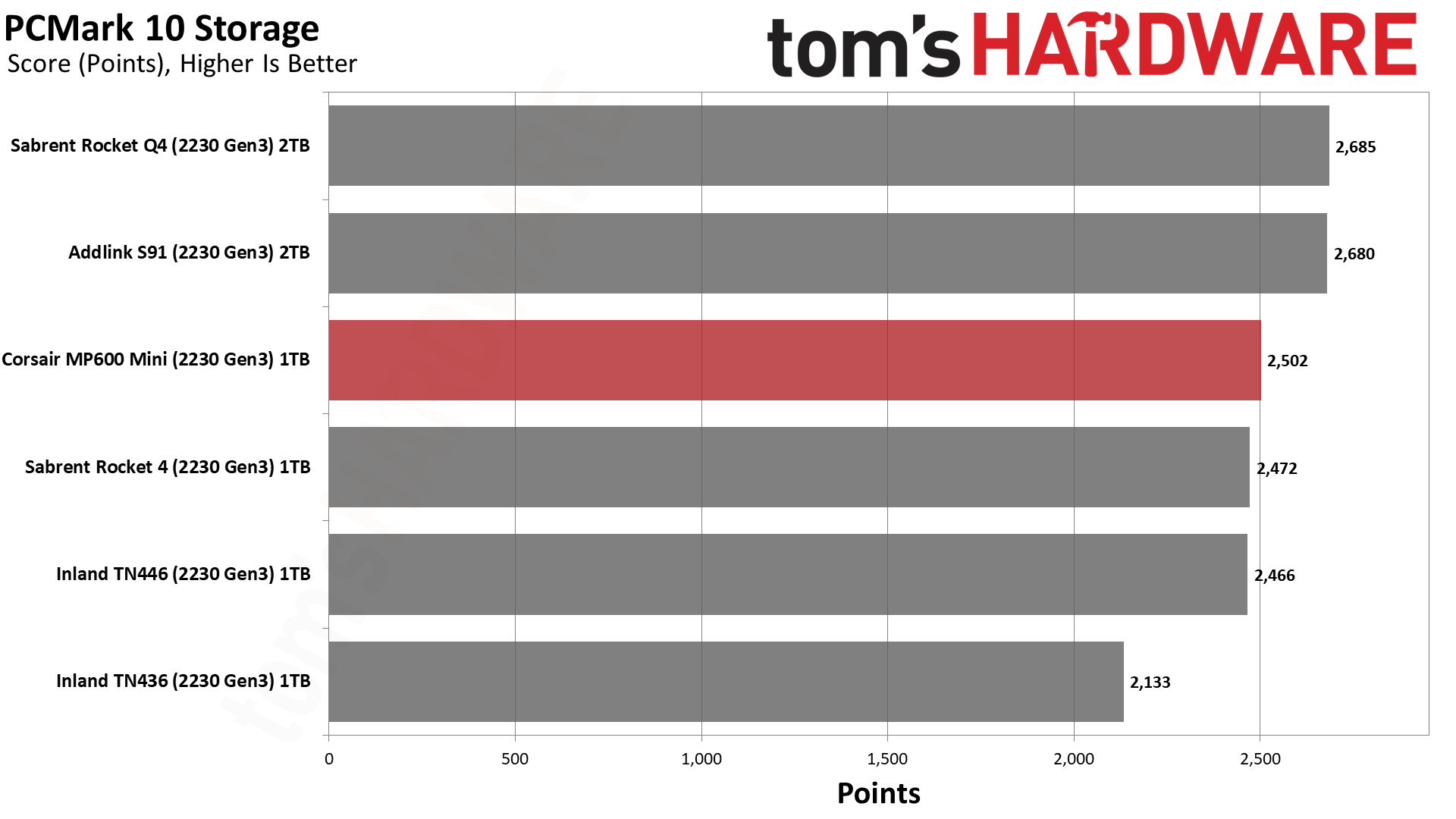

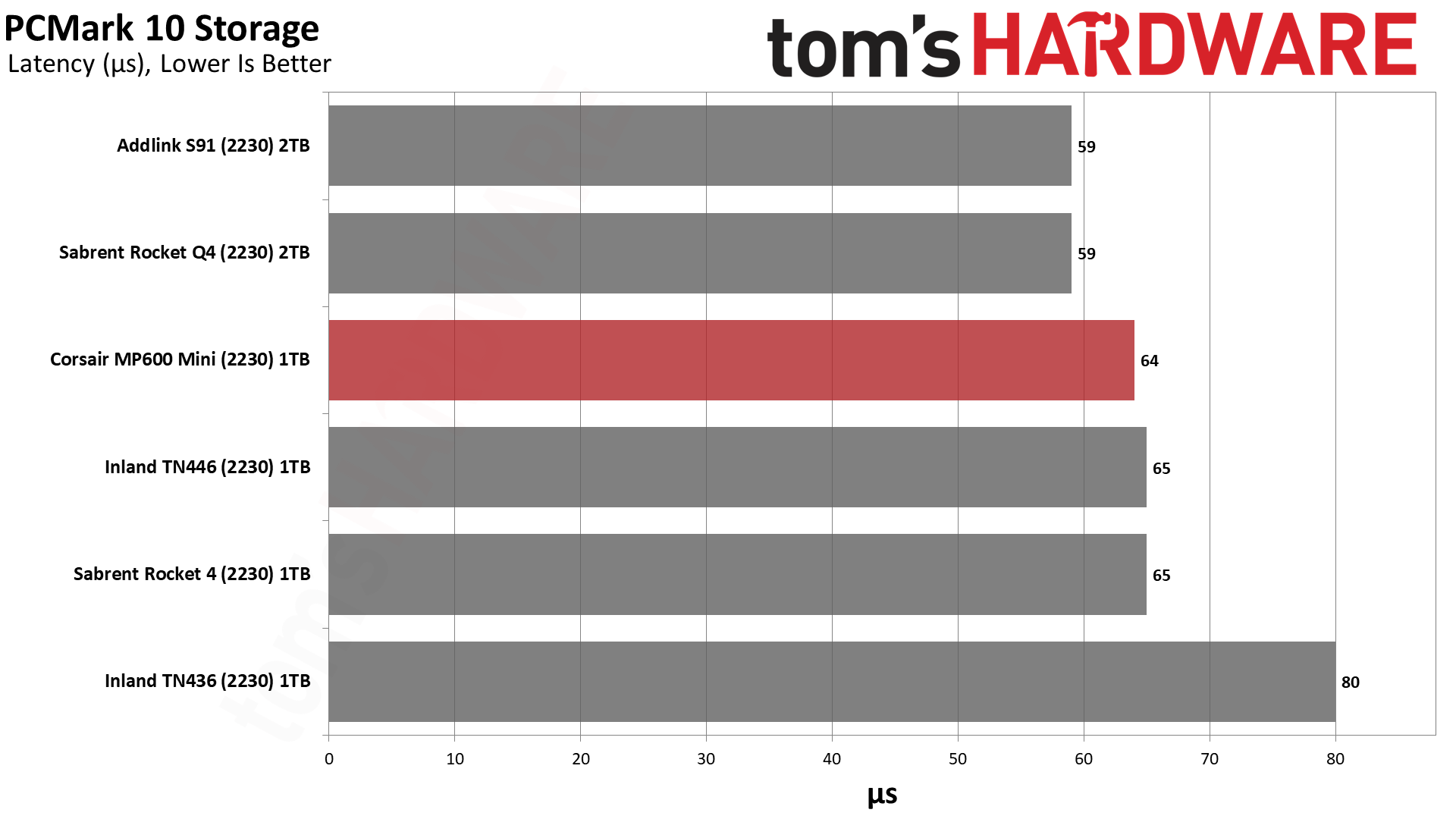
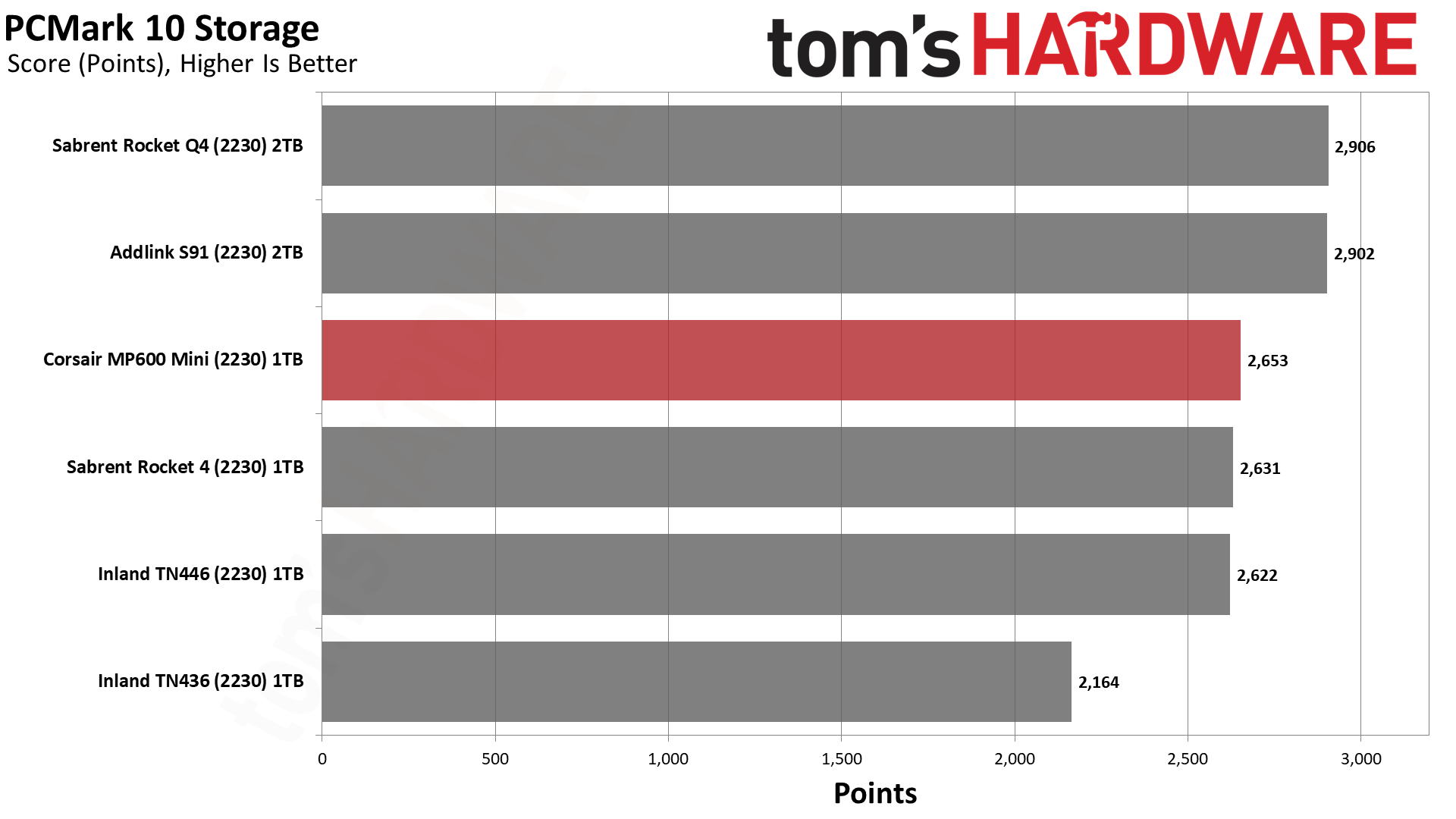
The QLC drives do better in PCMark 10, but the MP600 Mini’s score is not bad by any means. The QLC drives have massive pSLC caches compared to the restrained ones on the TLC drives, which can have interesting impacts on performance. One advantage of a large cache is that the drive can retain some data in pSLC for later reading, which makes more sense on a QLC drive as the native read latency is higher than pSLC and TLC.
PC Transfer Rates – DiskBench
We use the DiskBench storage benchmarking tool to test file transfer performance with a custom, 50GB dataset. We copy 31,227 files of various types, such as pictures, PDFs, and videos to a new folder and then follow-up with a reading test of a newly-written 6.5GB zip file.
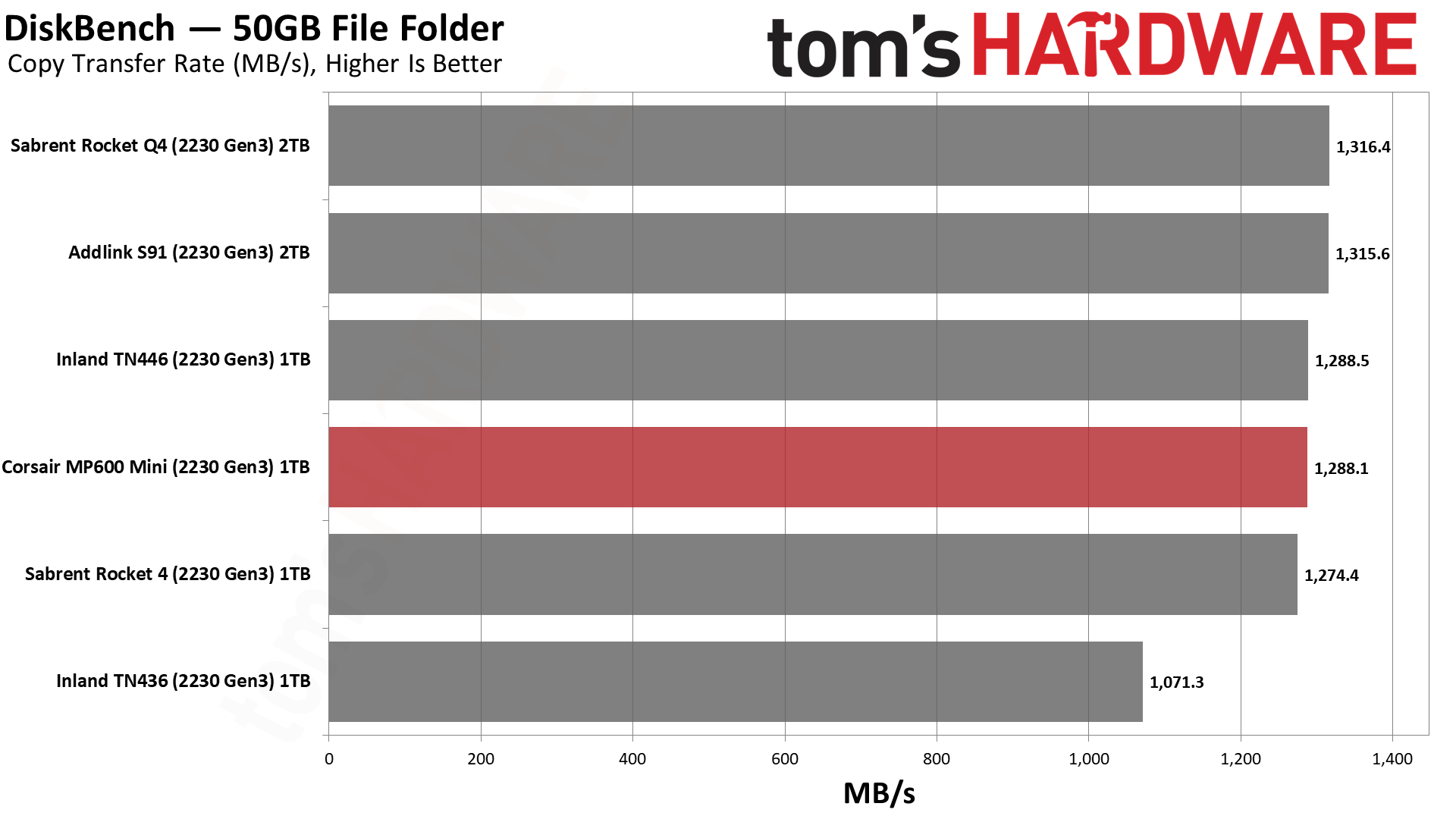
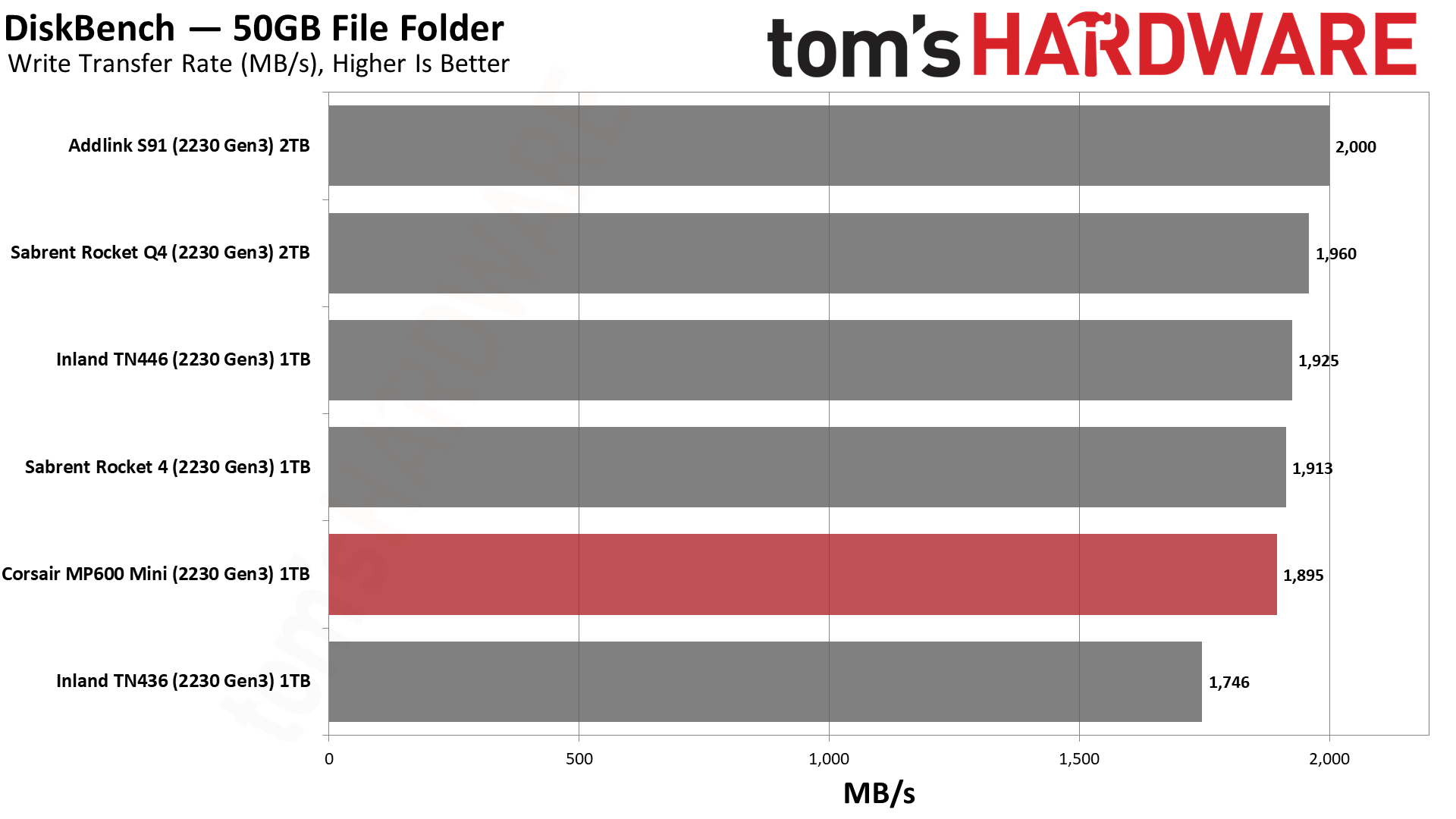
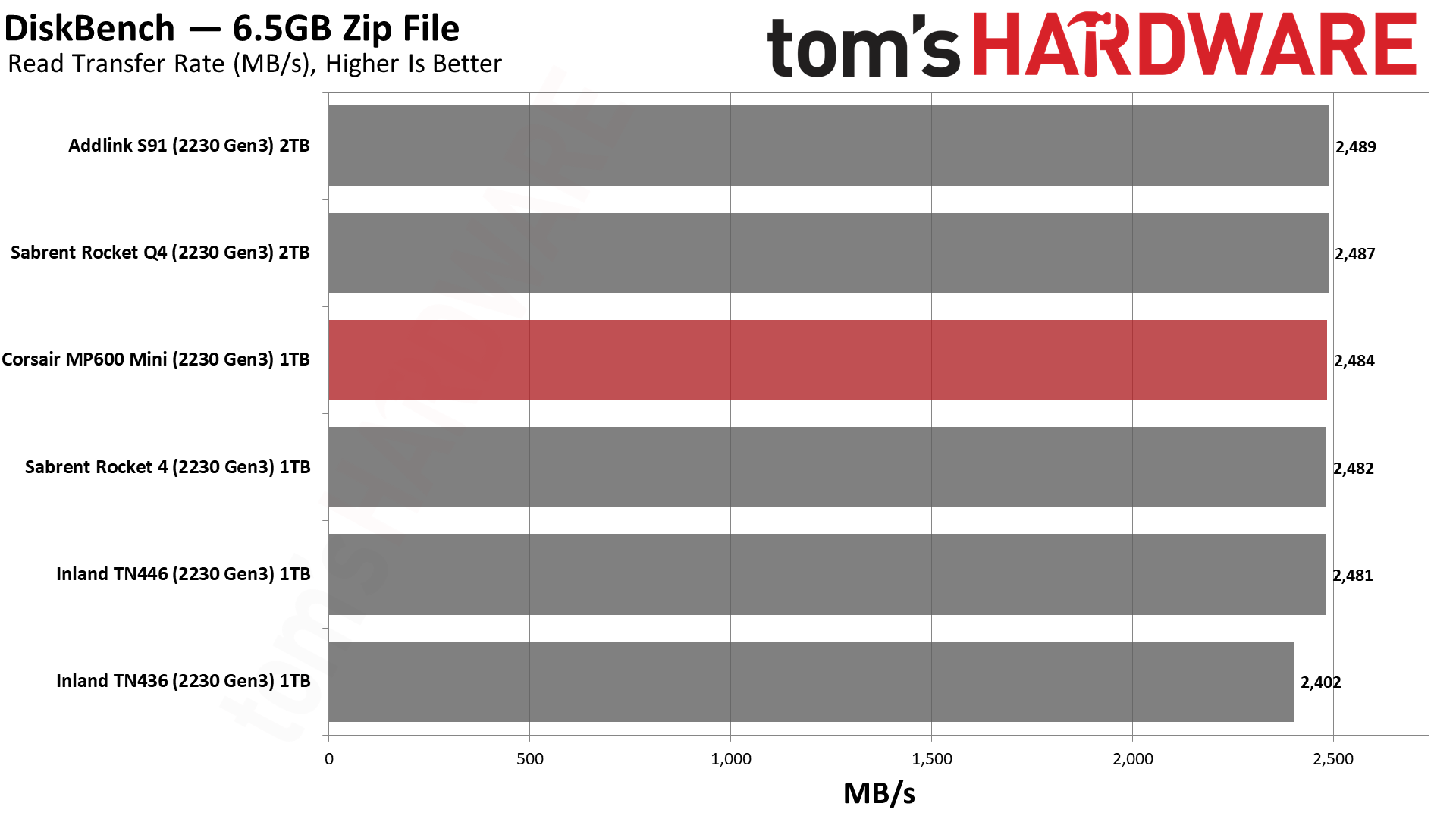
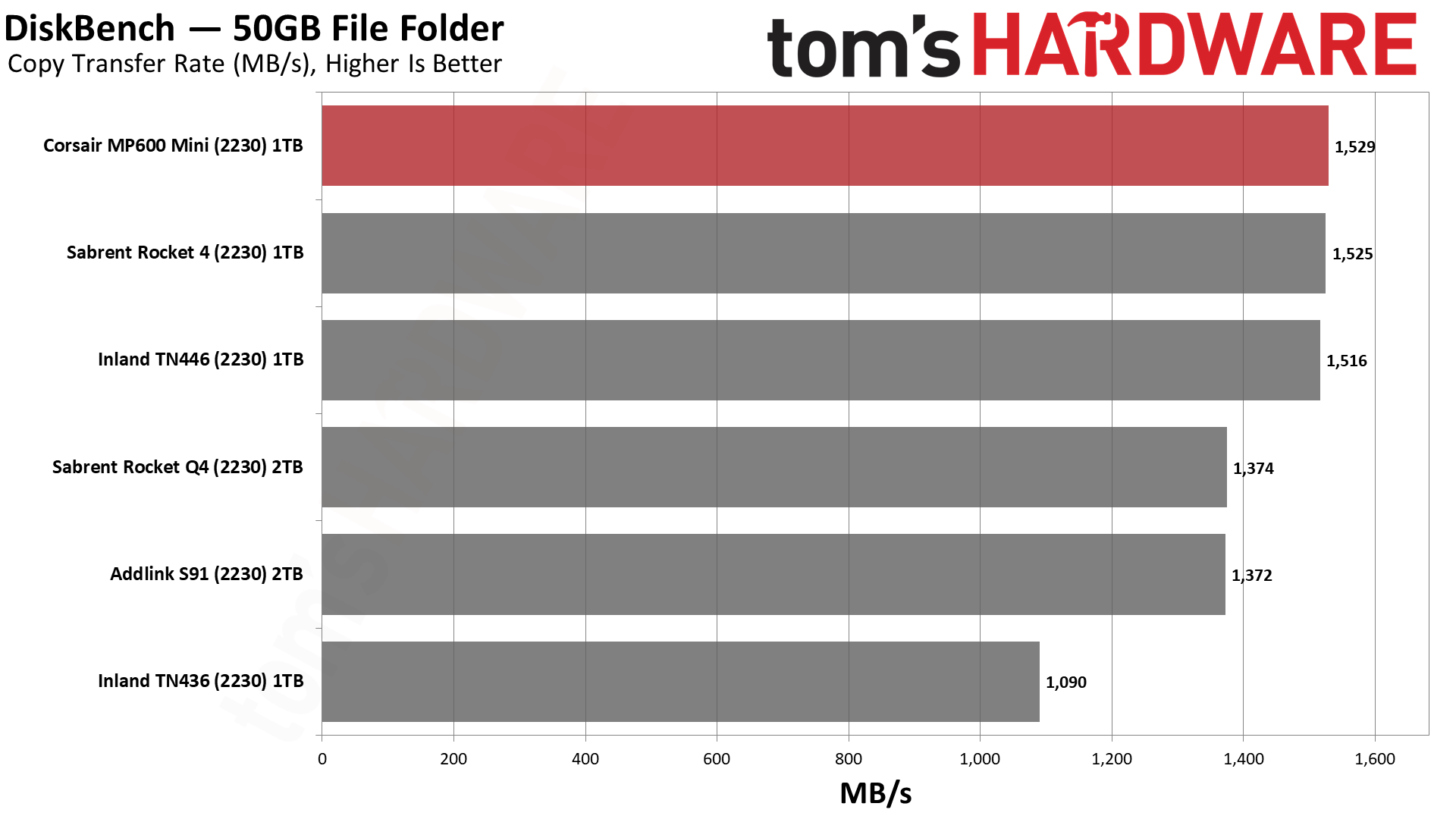
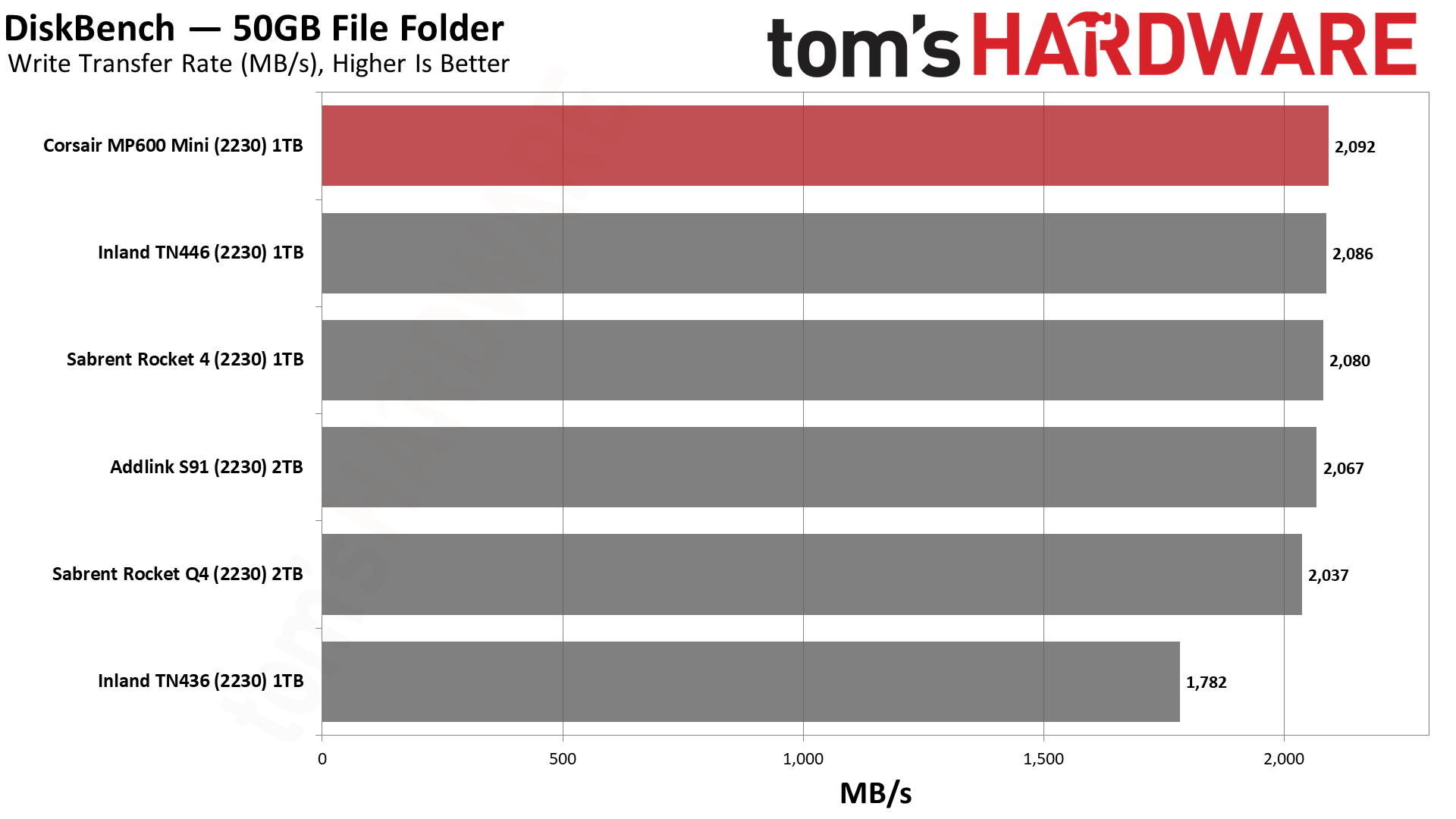
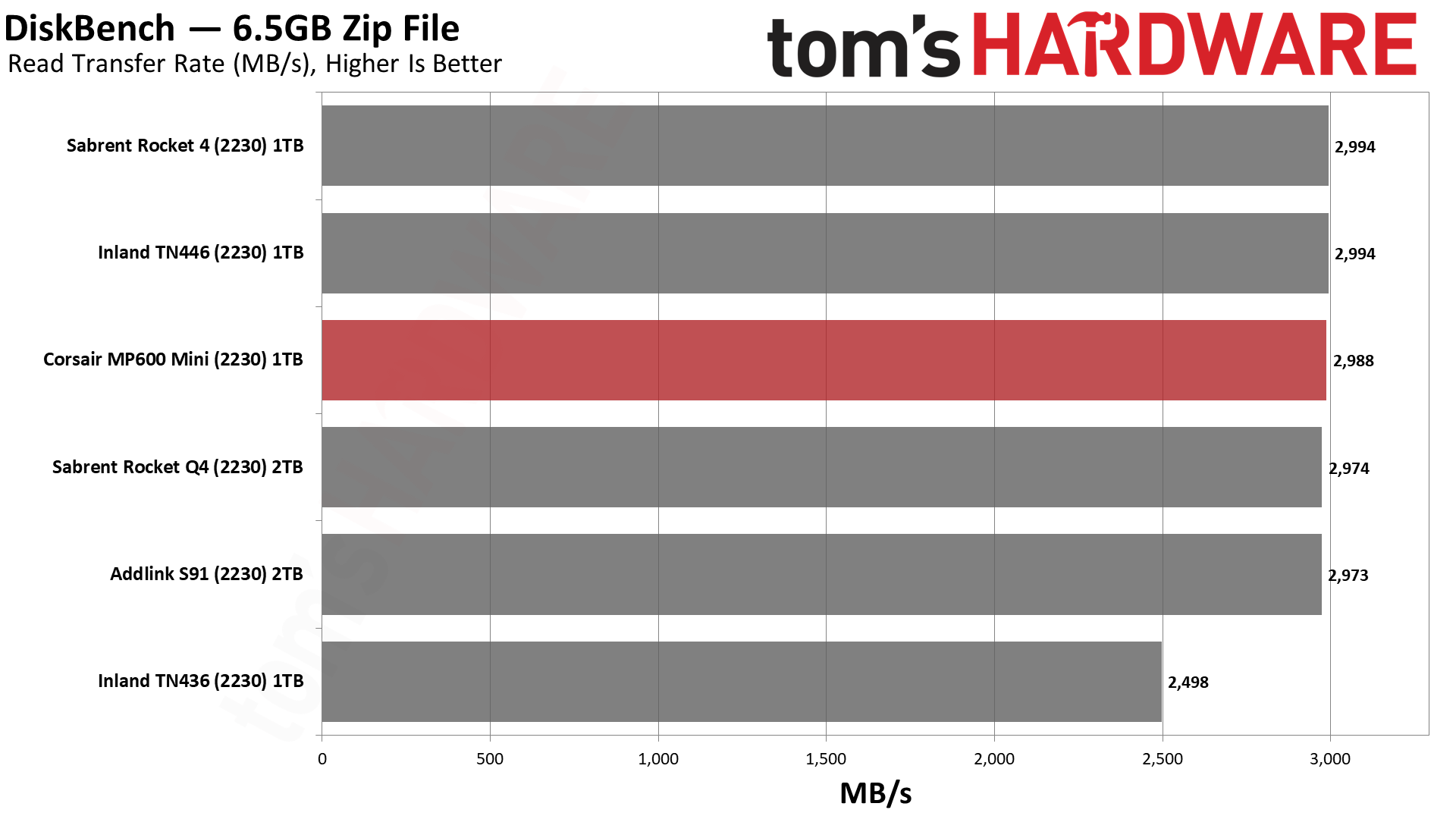
The DiskBench results are predictable with the TLC drives, including the MP600 Mini, pulling away in PCIe 4.0 mode. In PCIe 3.0 mode, the drives perform very similarly. This does imply that a QLC drive would work well with the Steam Deck for this type of workload, while the ROG Ally can eke out more storage performance.
PC Synthetic Testing - ATTO / CrystalDiskMark
ATTO and CrystalDiskMark (CDM) are free and easy-to-use storage benchmarking tools that SSD vendors commonly use to assign performance specifications to their products. Both of these tools give us insight into how each device handles different file sizes.
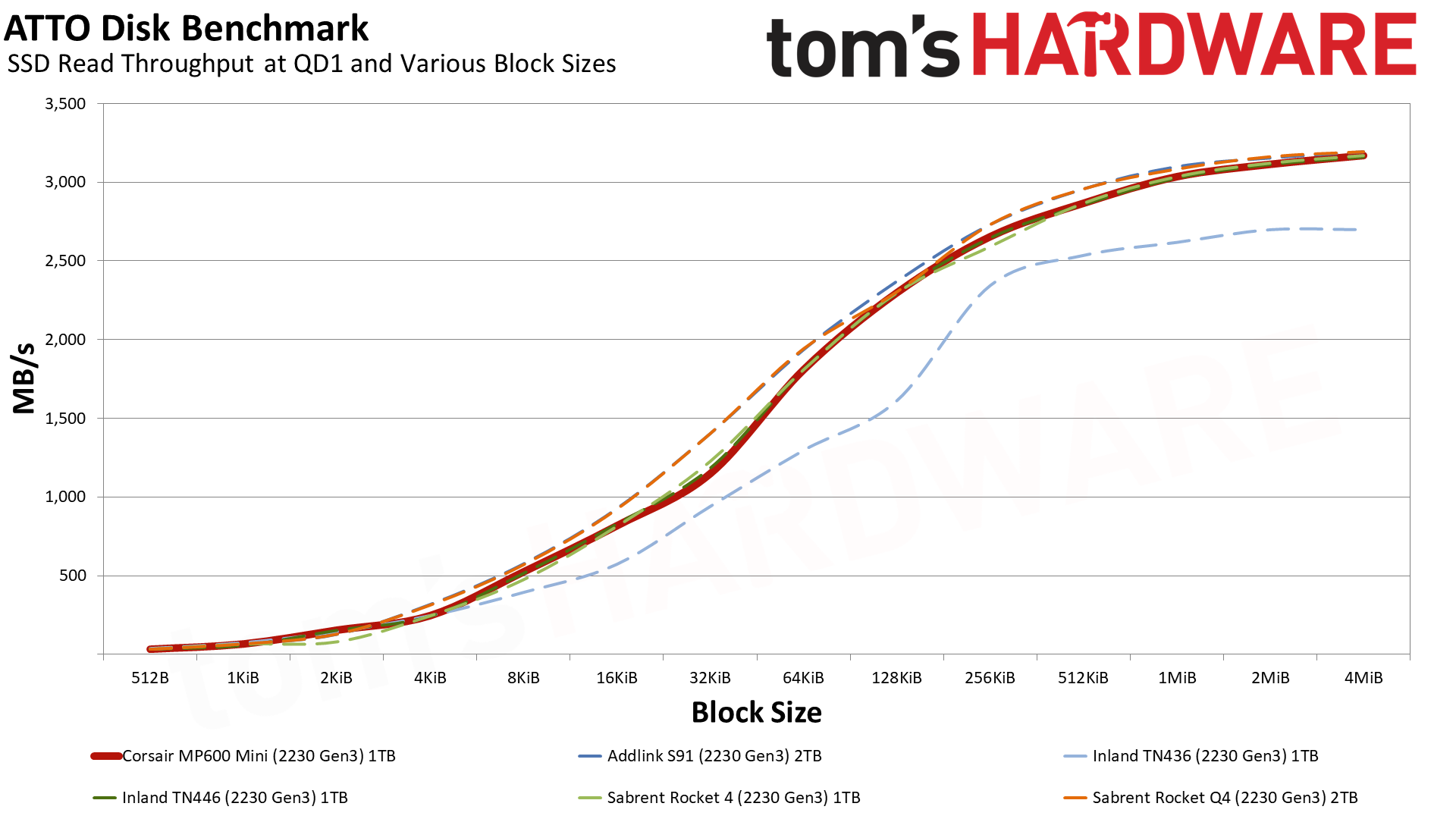
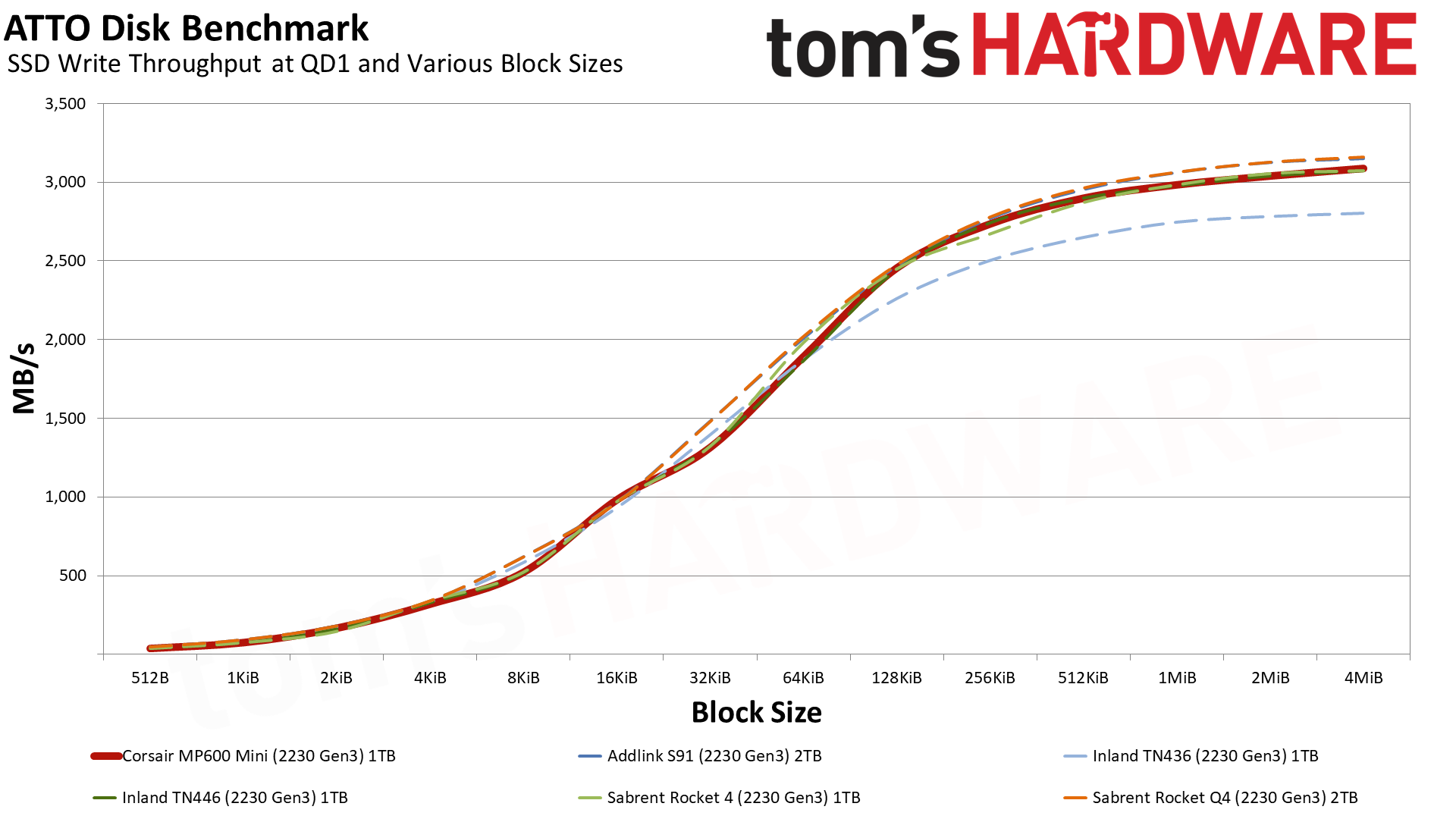

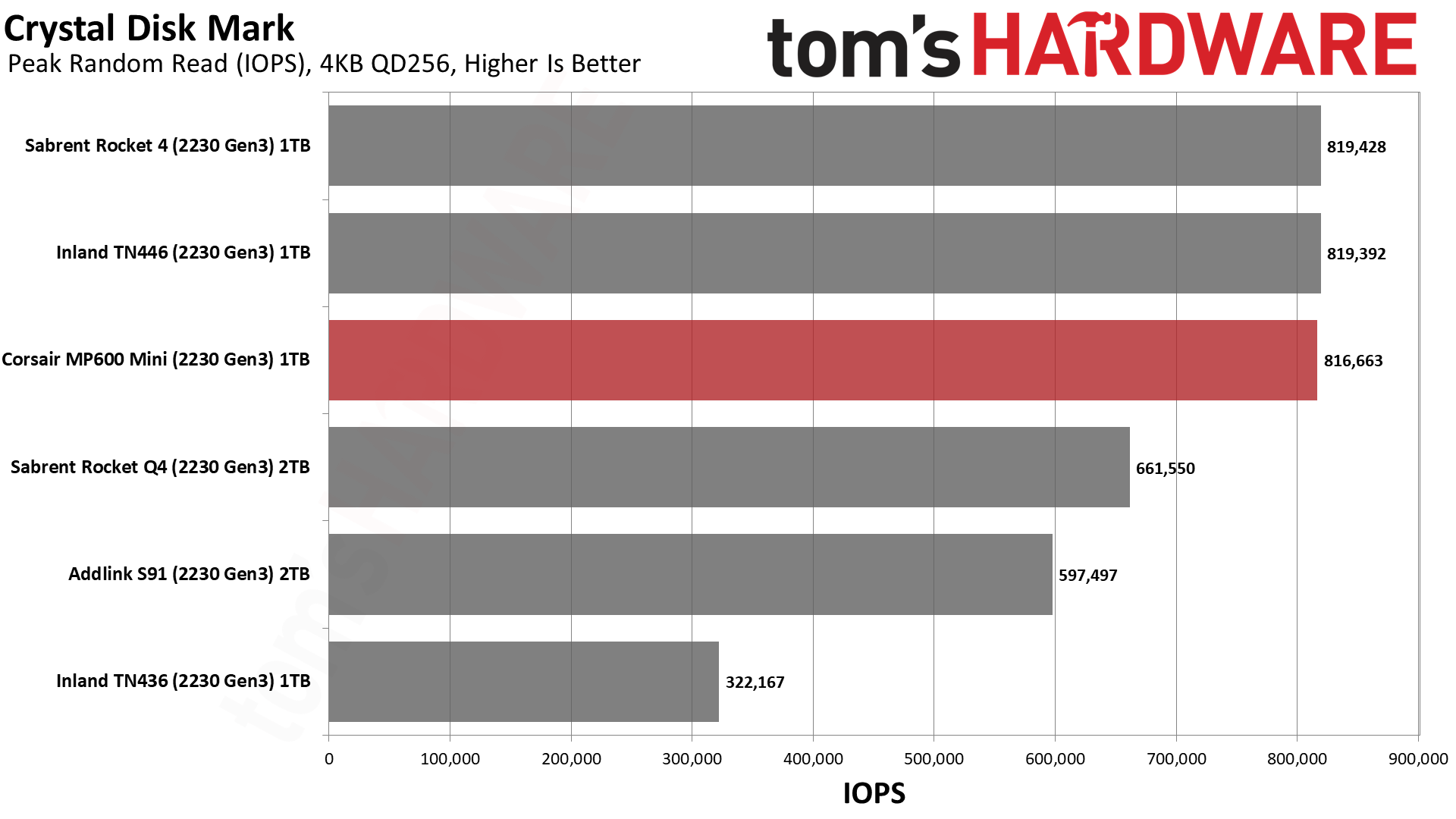
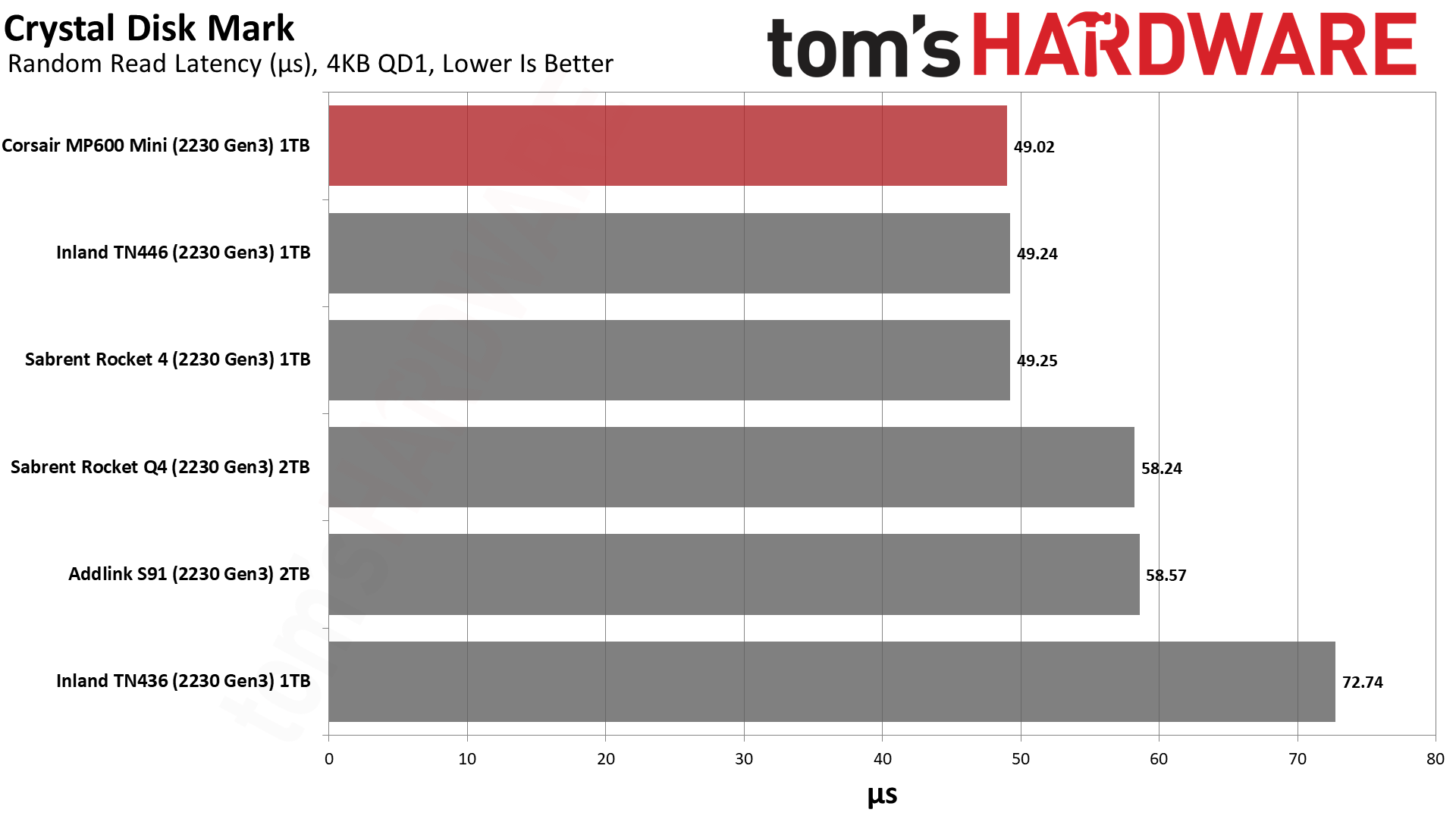
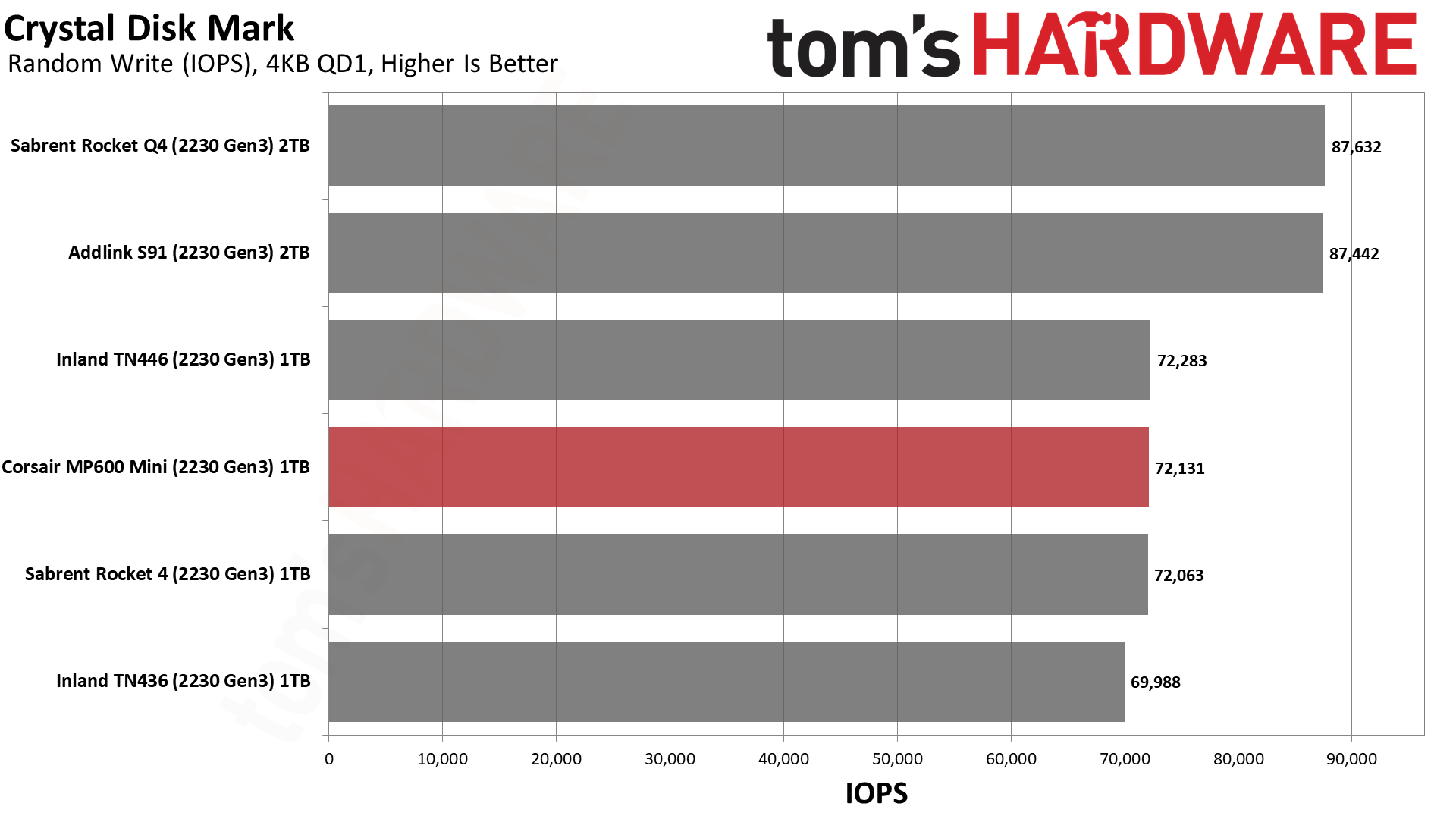
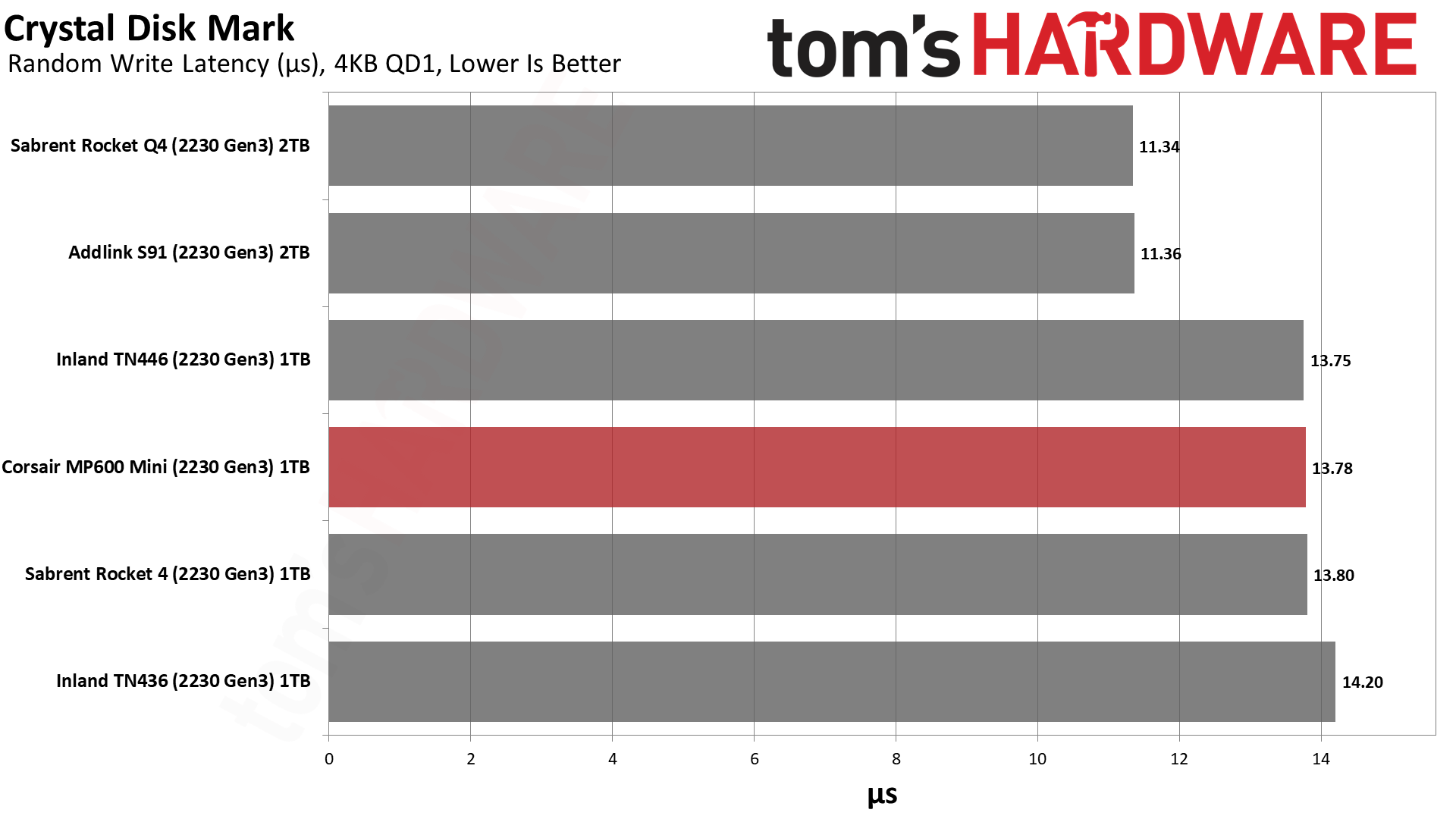
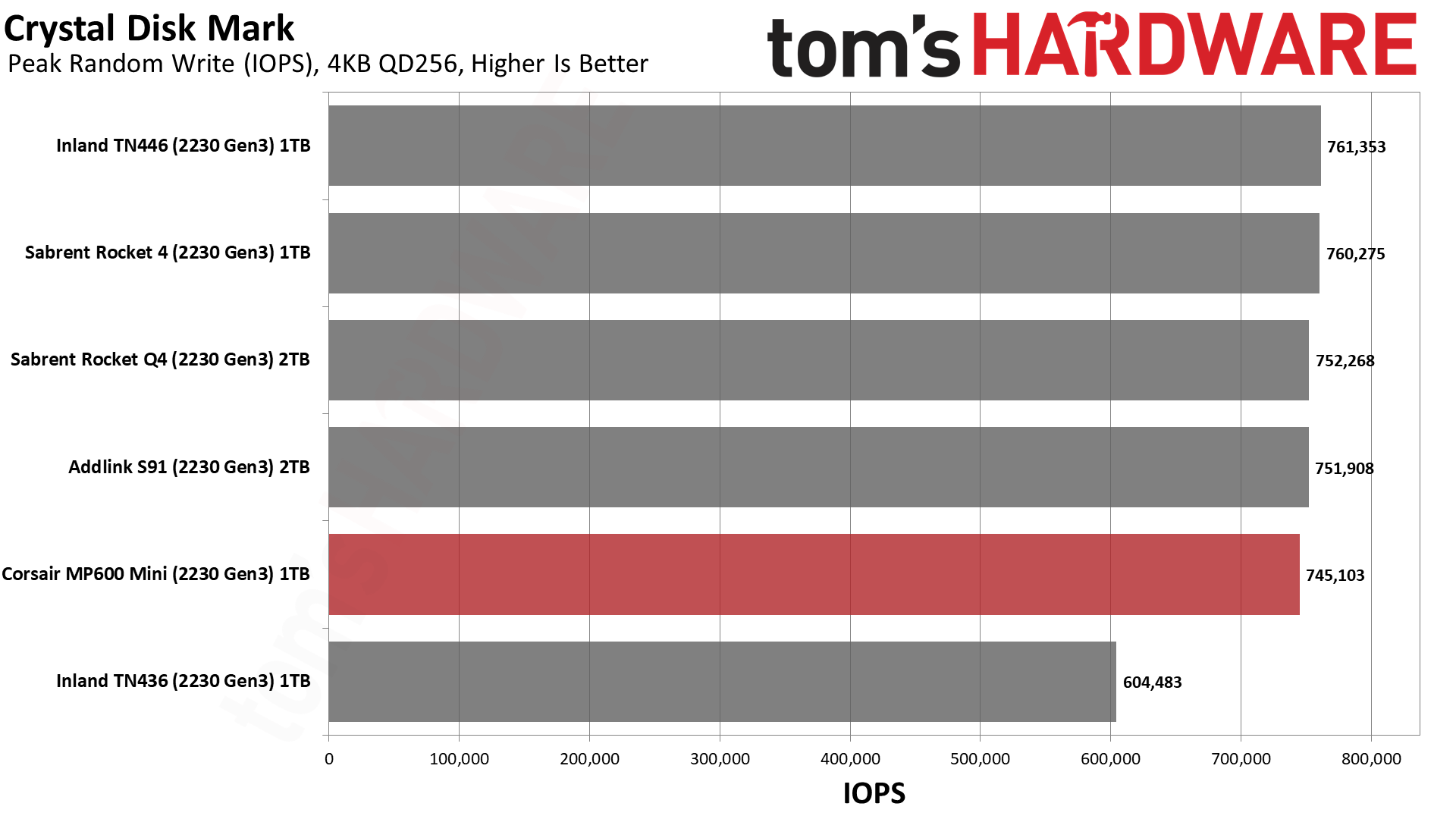
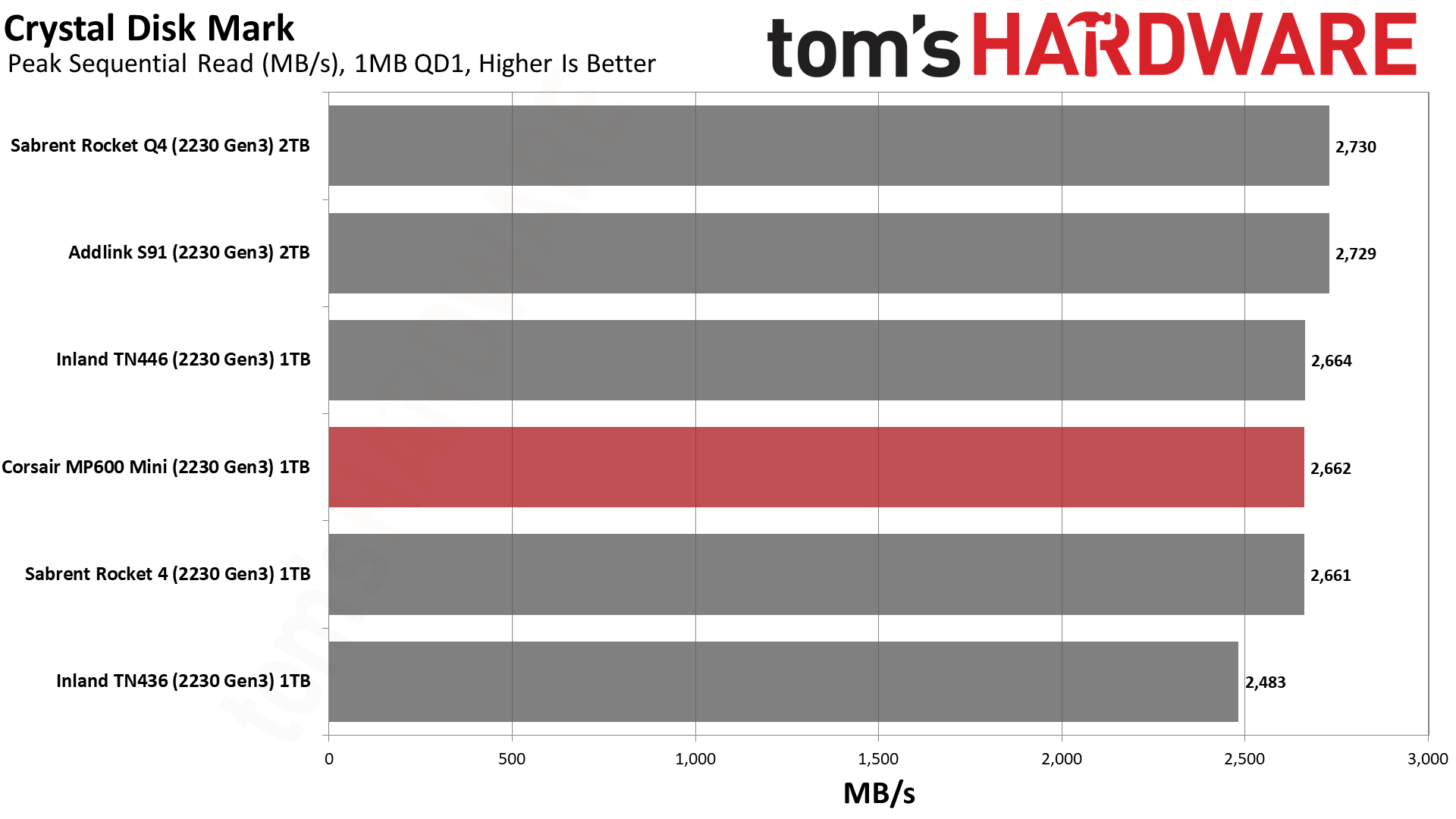
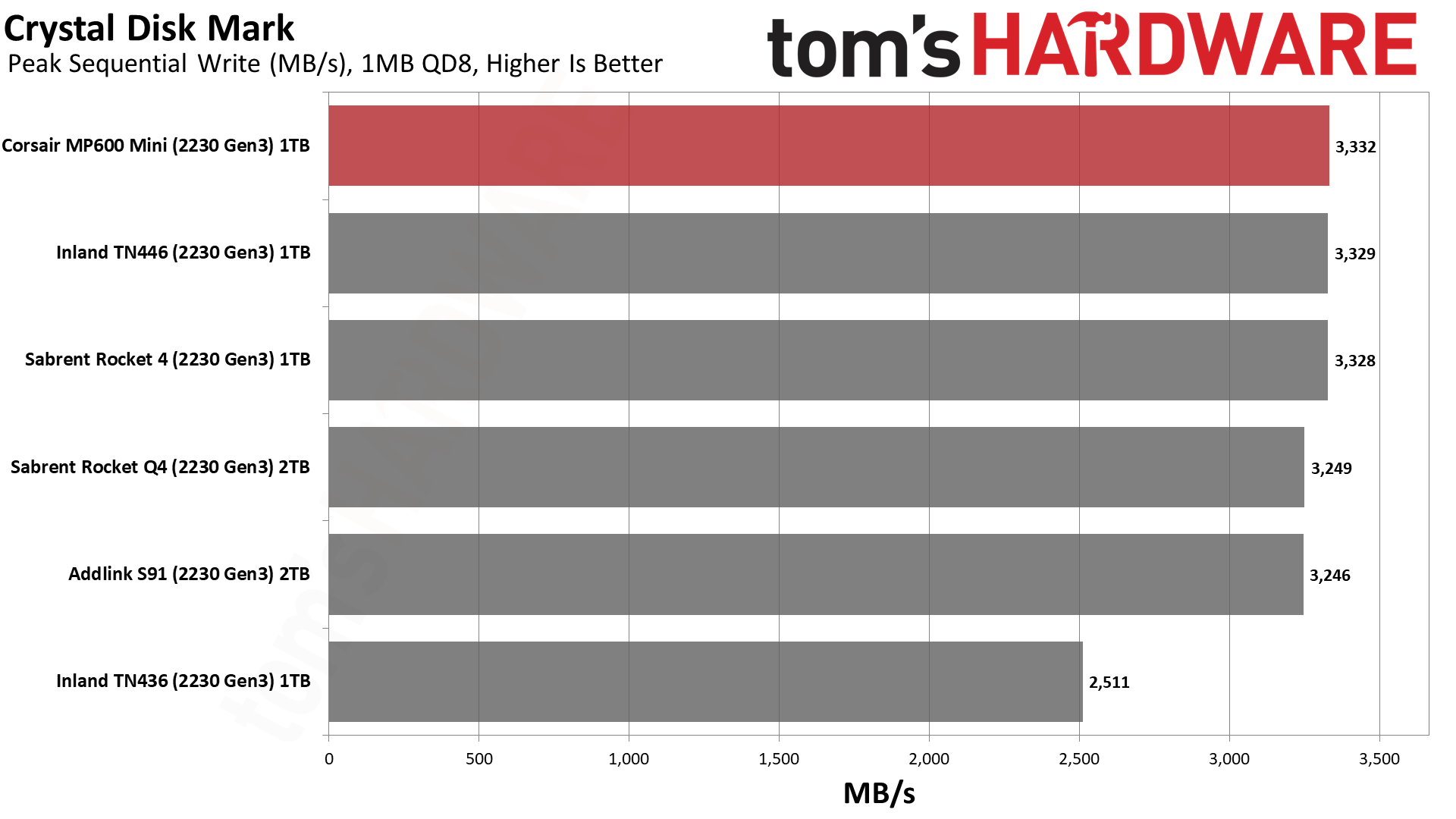
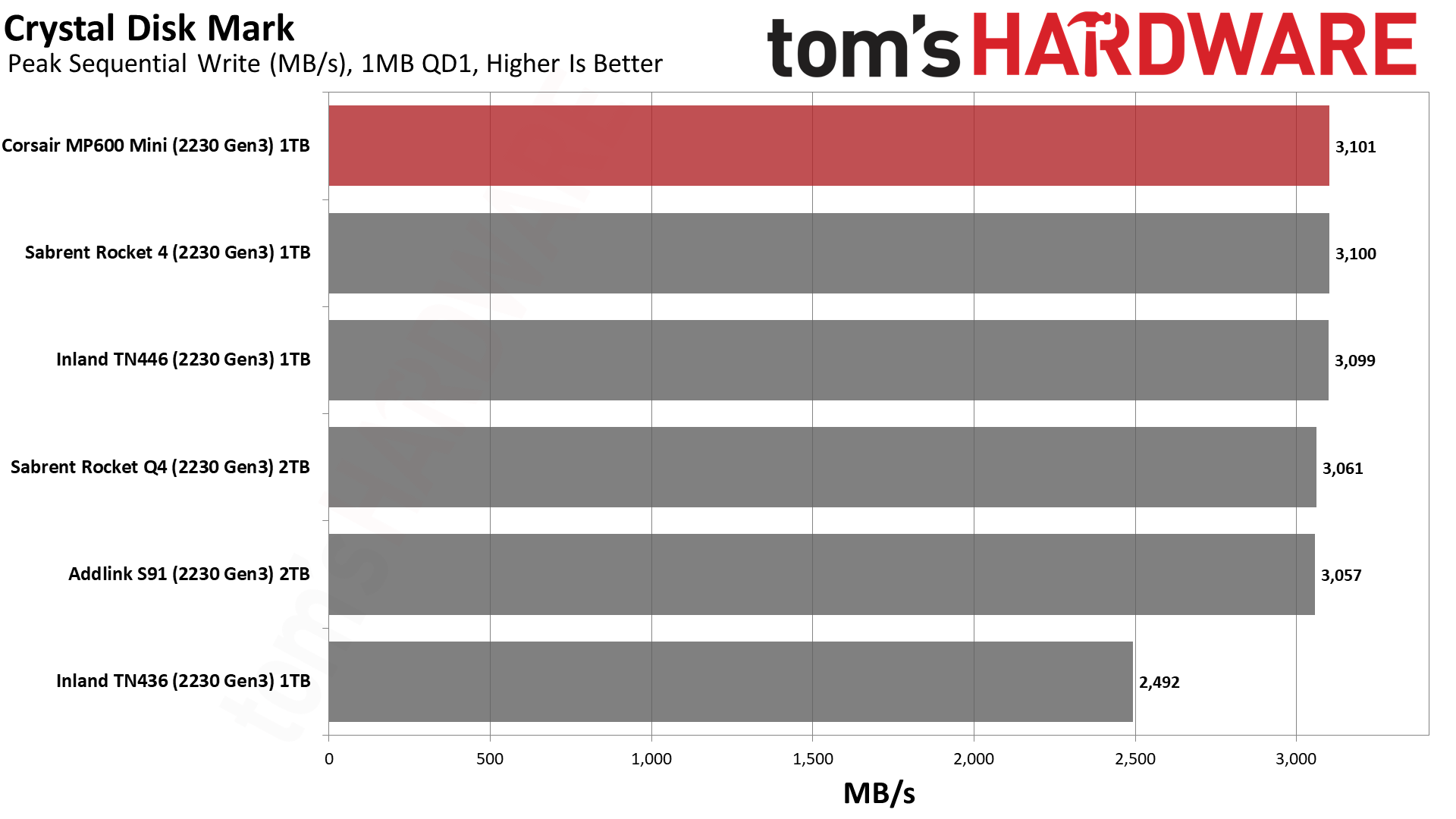
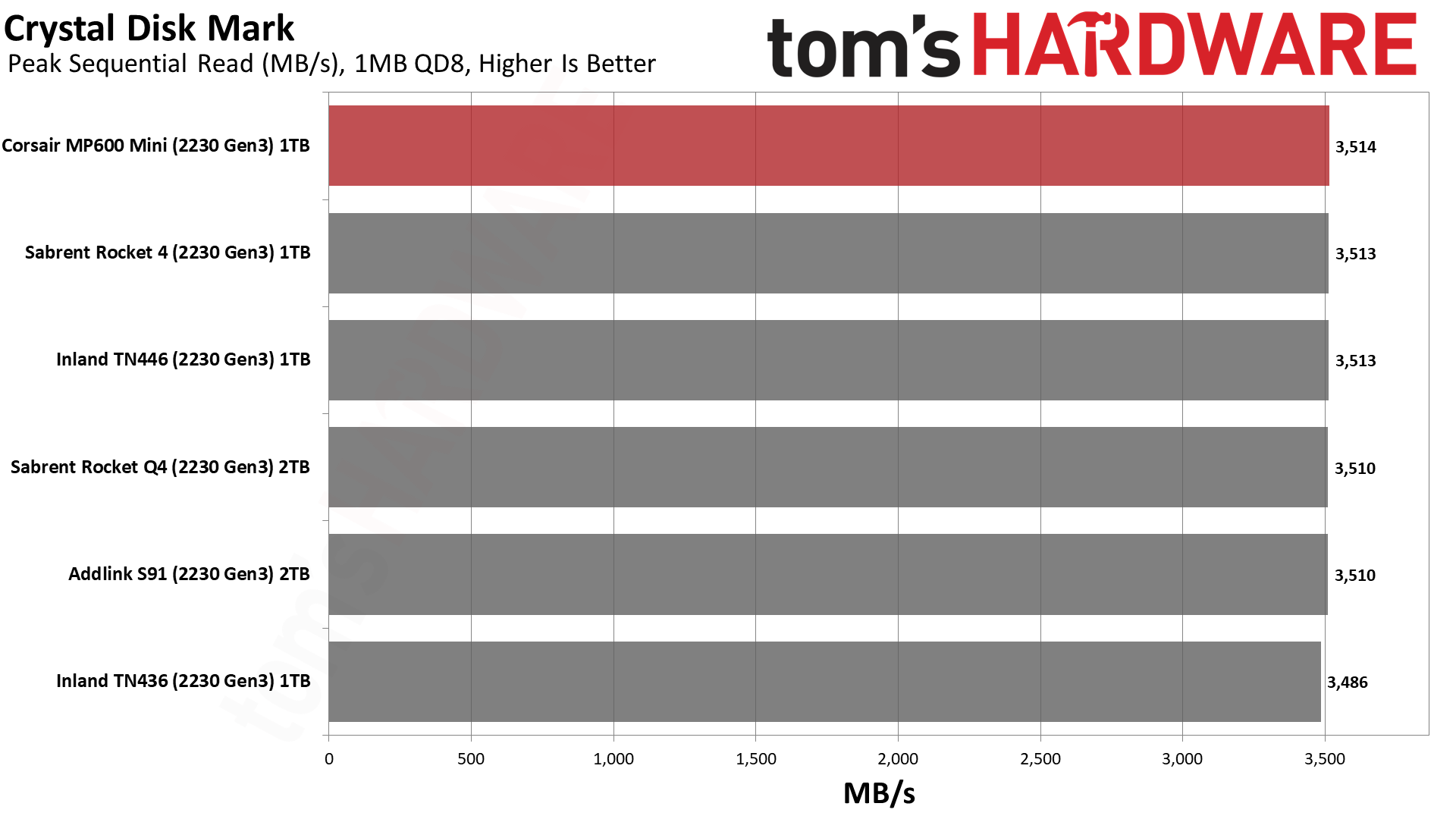



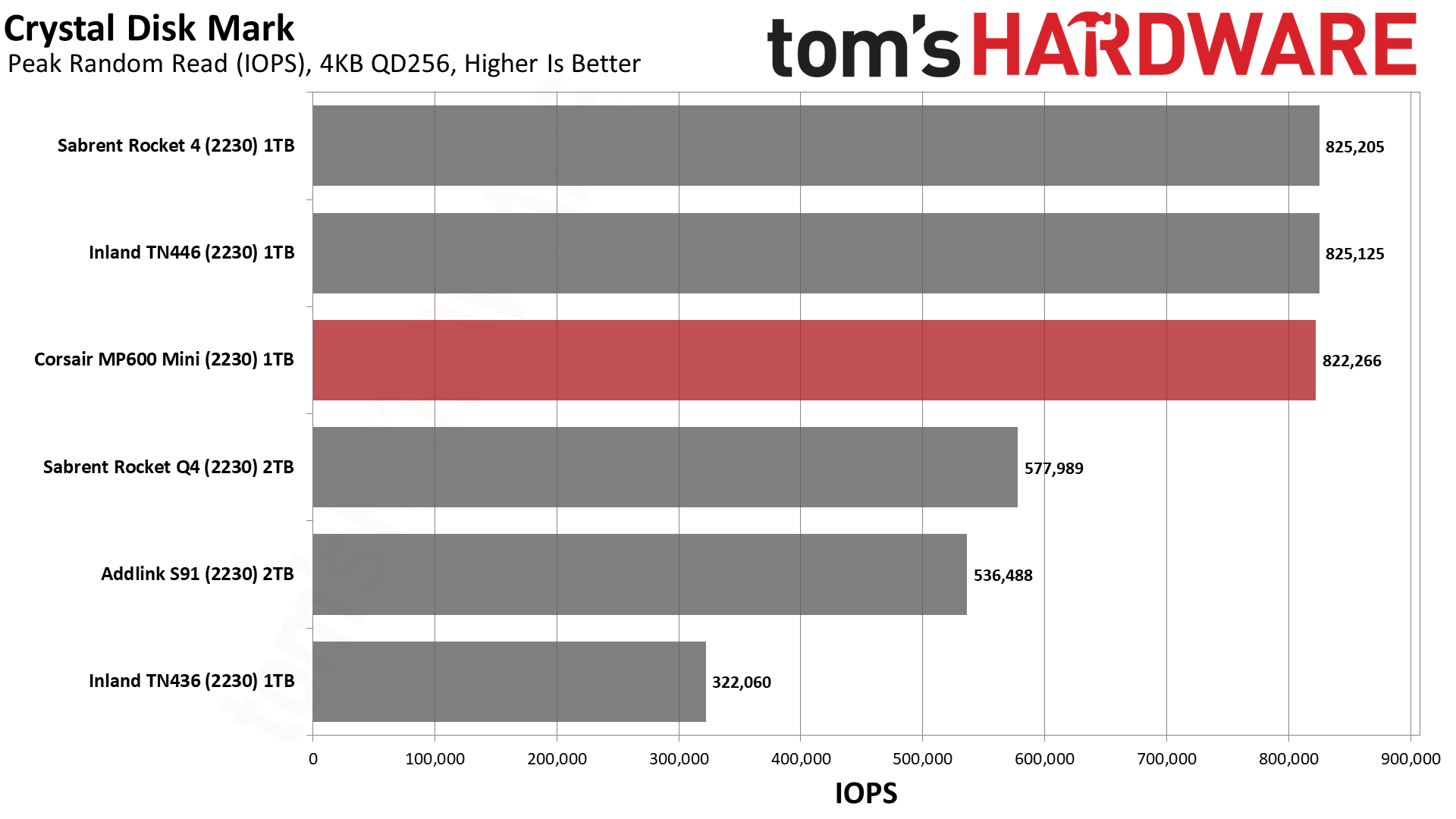
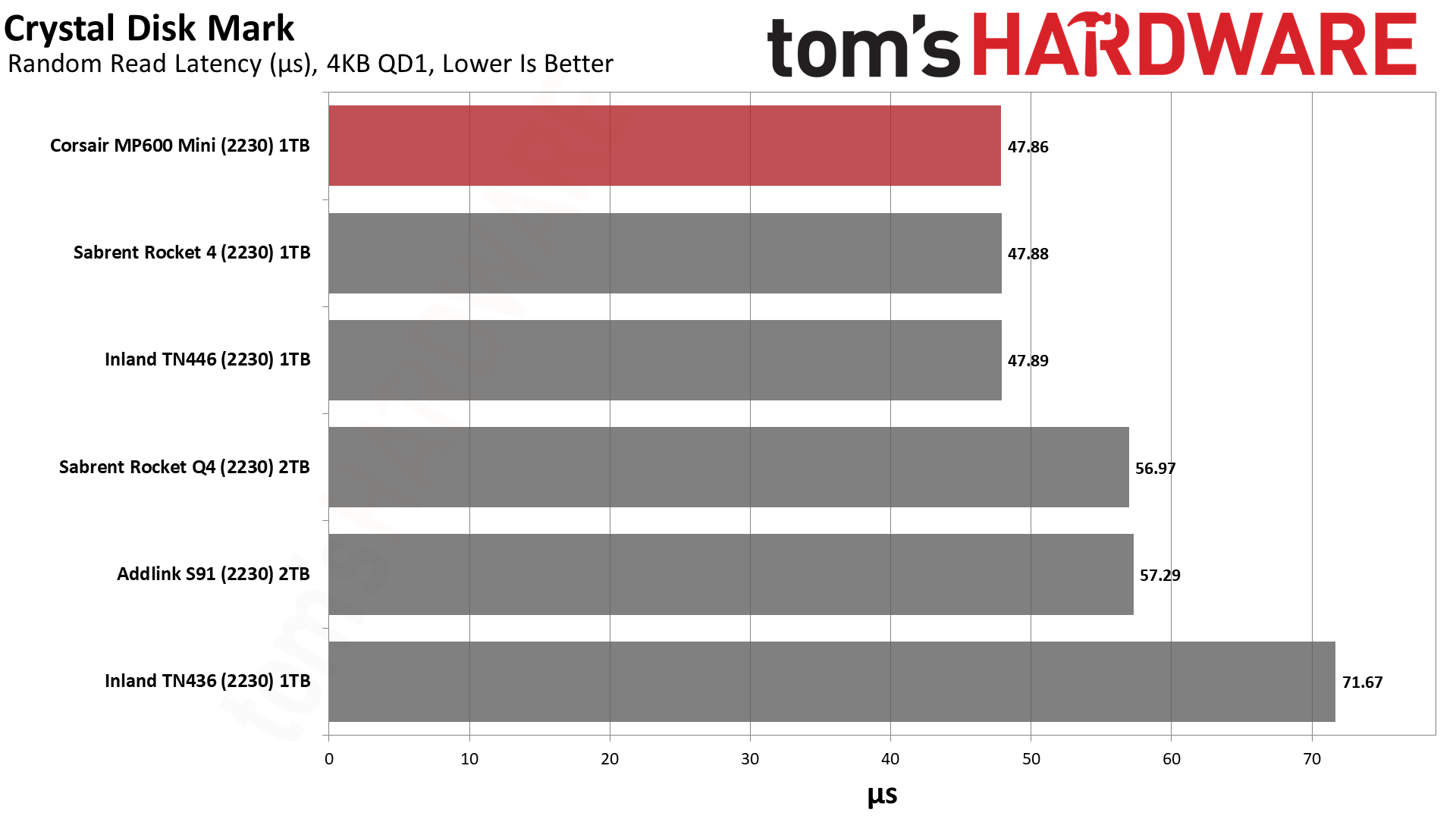
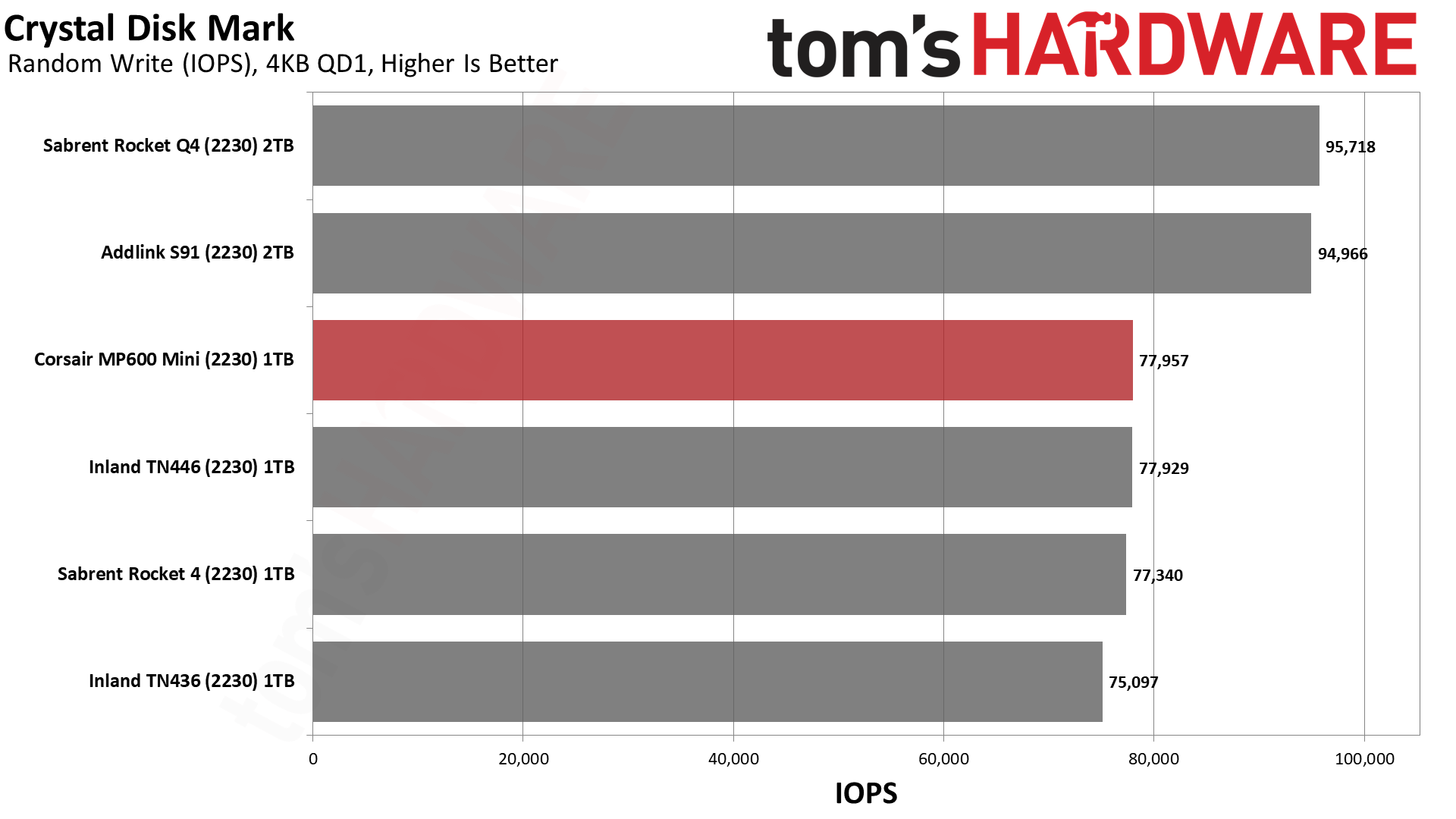



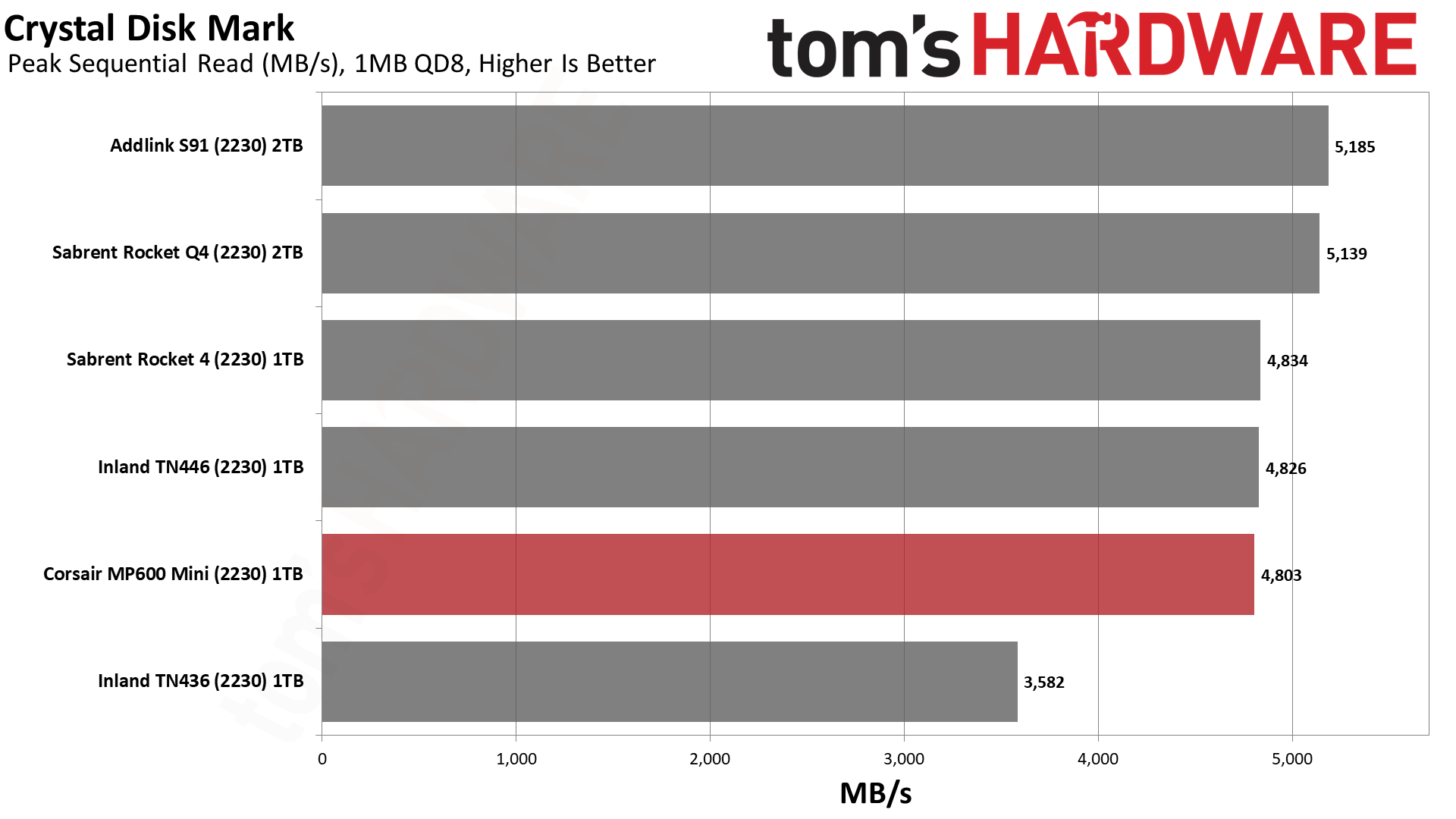
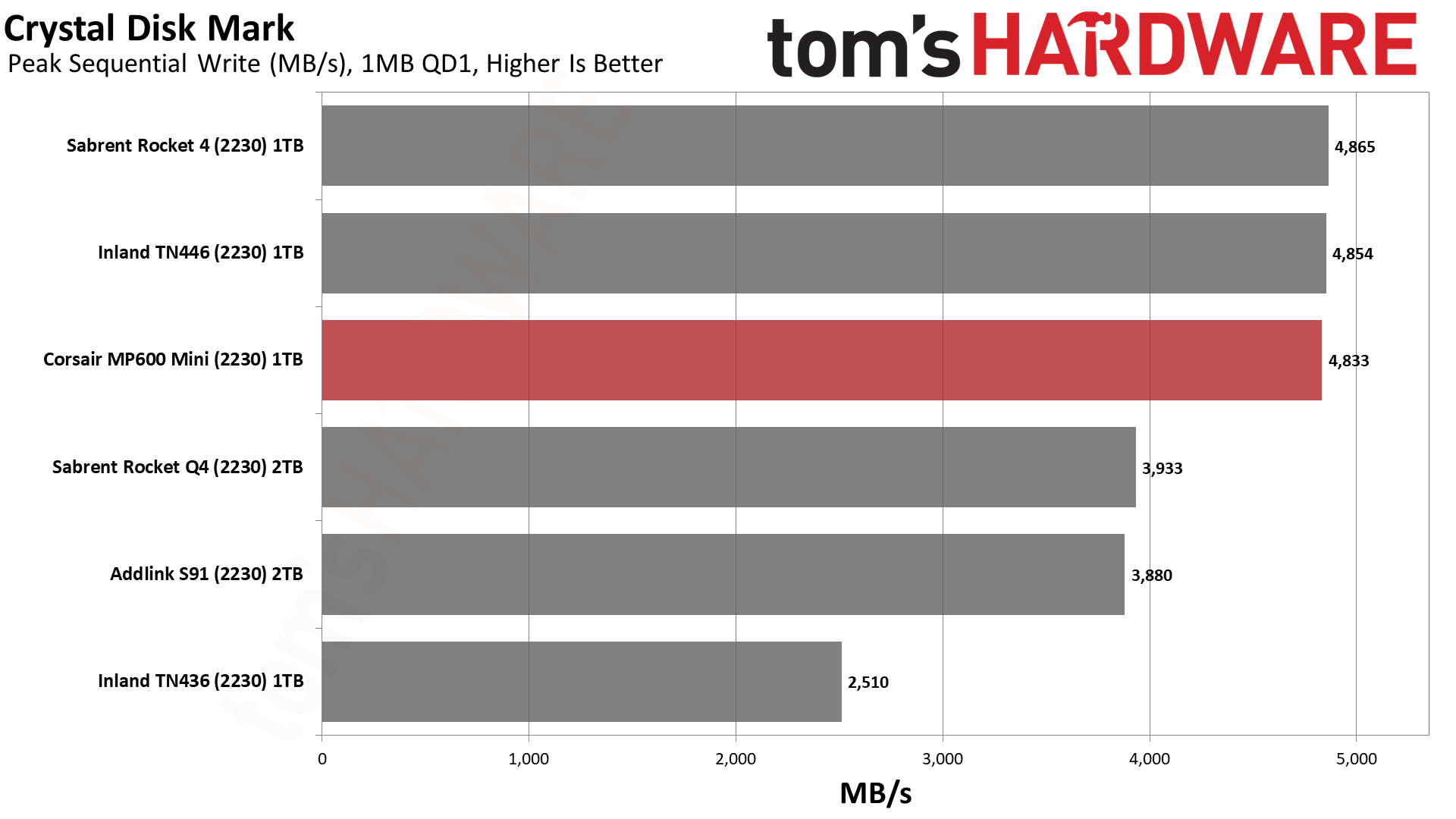
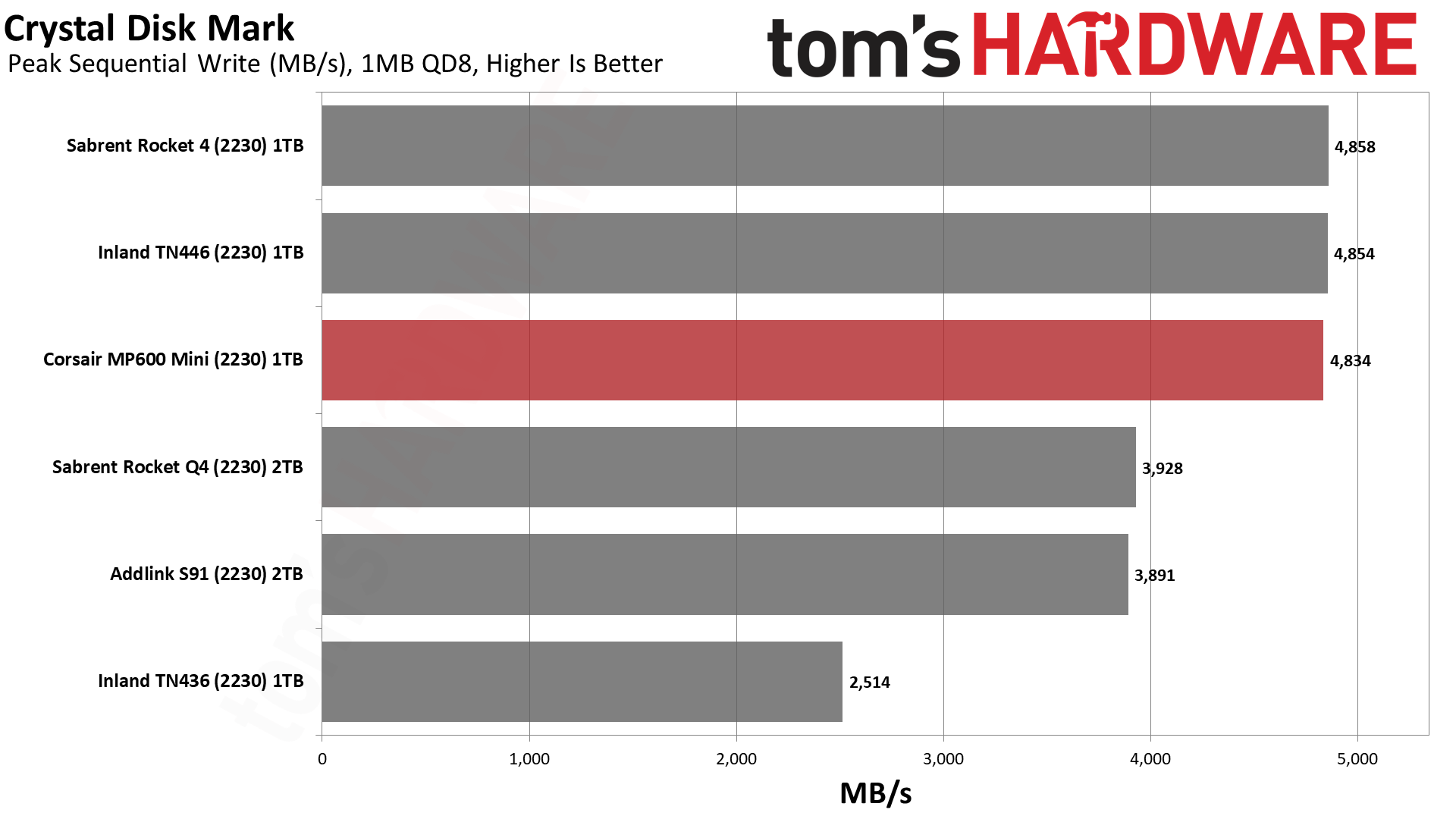
ATTO performance is good to excellent with the MP600 Mini, as anticipated. Sequential performance in CrystalDiskMark (CDM) is also good to great compared to the competition. In PCIe 4.0 mode, the TLC drives, like the MP600 Mini, pull away during sequential write workloads. Noticeably, the TLC drives have significantly better 4KB read latency, which is an important result. Real-world impact is probably not large, but the difference is there.
PC Sustained Write Performance and Cache Recovery
Official write specifications are only part of the performance picture. Most SSDs implement a write cache, which is a fast area of (usually) pseudo-SLC programmed flash that absorbs incoming data. Sustained write speeds can suffer tremendously once the workload spills outside of the cache and into the "native" TLC or QLC flash.
We use Iometer to hammer the SSD with sequential writes for 15 minutes to measure both the size of the write cache and performance after the cache is saturated. We also monitor cache recovery via multiple idle rounds.

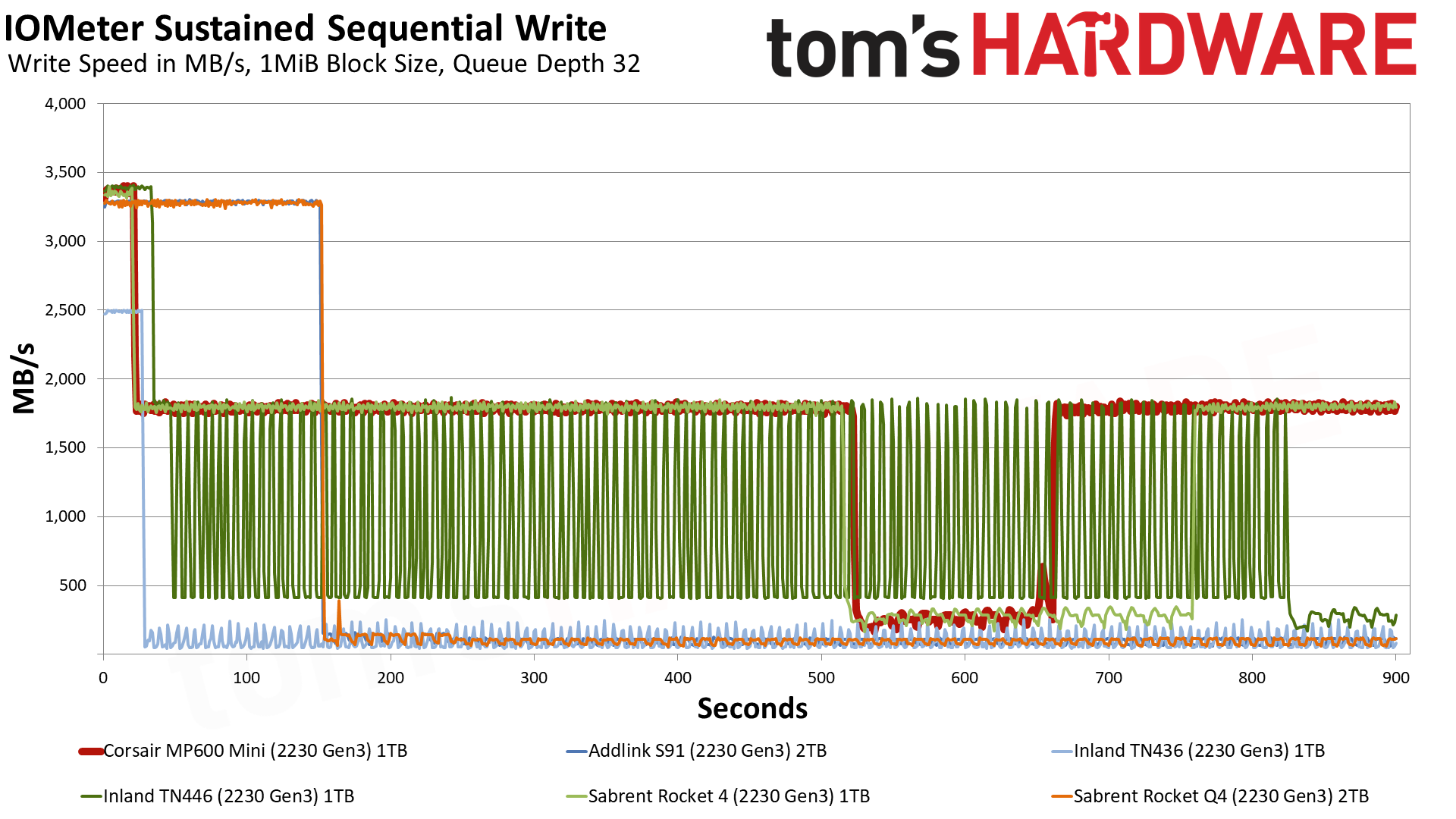
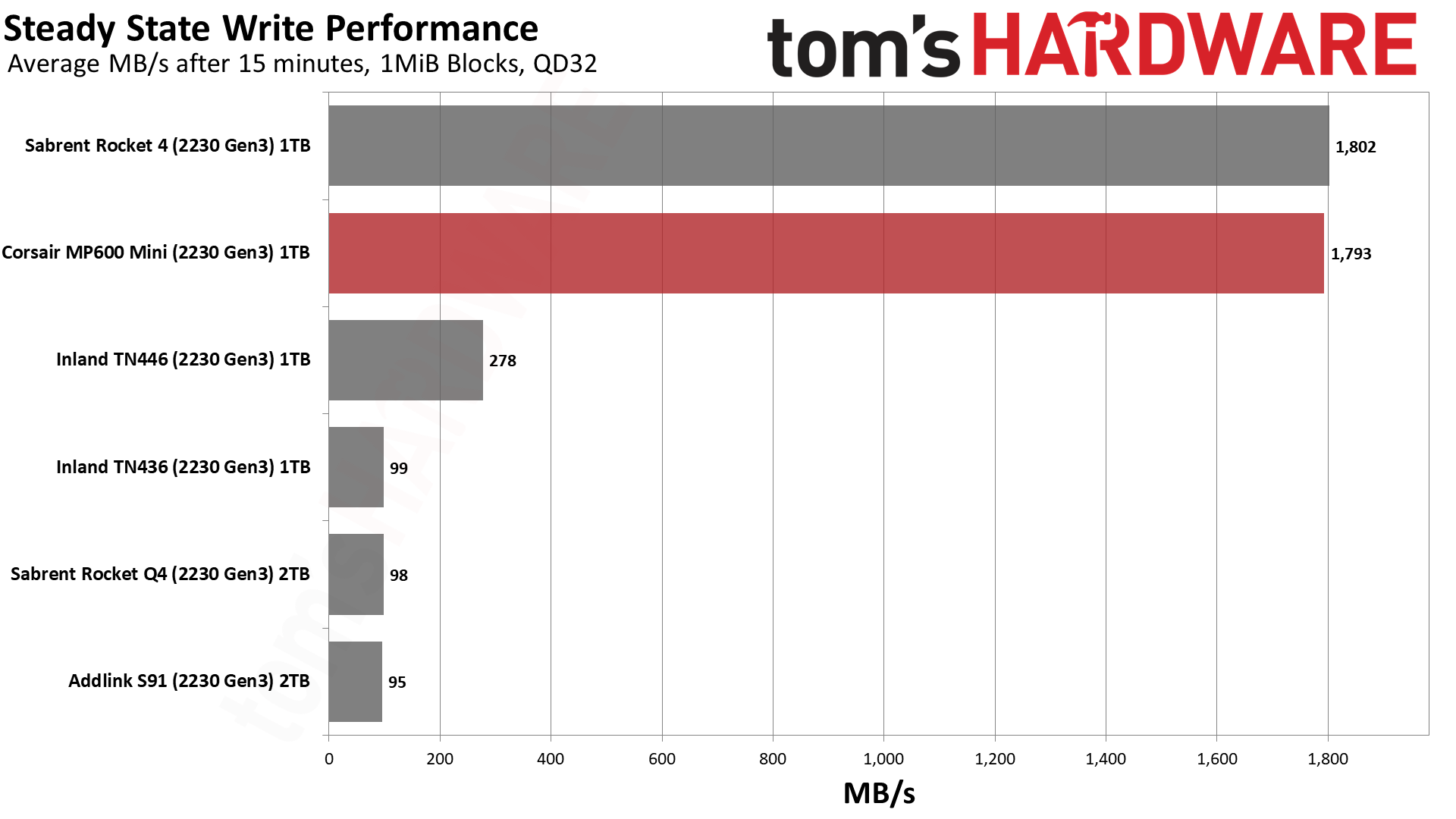


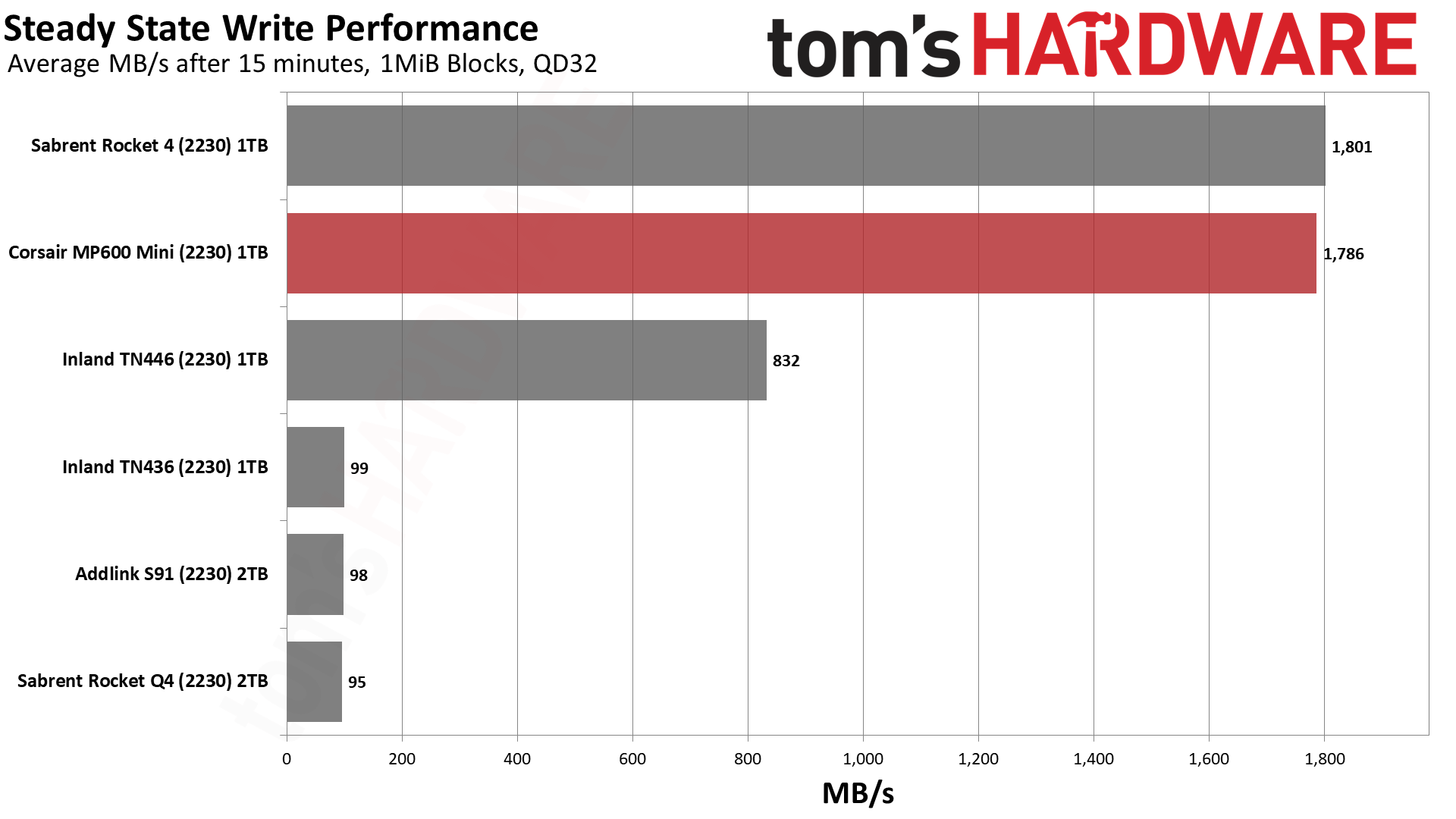
The MP600 Mini writes at its maximum speed for over 20 seconds in both PCIe 3.0 and 4.0 modes. In the former, its pSLC cache is similar in size to the TN446 and Rocket 2230 at around 70GB. In the latter, it appears to be larger, closer to 100GB, as it is writing for the same amount of time but at a higher speed without the restriction of a PCIe 3.0 interface. This does not impact the average write performance, with steady state performance and TLC mode at about 1.8 GB/s. The different cache does have implications for the MP600 Mini’s use in the PCIe 4.0 ROG Ally, but the impact should be small.
The drive can maintain relatively decent performance in its TLC mode and can afford to take some time to recover its pSLC. The QLC drives rely more on pSLC and, with their large caches, must recover more quickly.
Power Consumption
We use the Quarch HD Programmable Power Module to gain a deeper understanding of power characteristics. Idle power consumption is an important aspect to consider, especially if you're looking for a laptop upgrade as even the best ultrabooks can have mediocre storage.
Some SSDs can consume watts of power at idle while better-suited ones sip just milliwatts. Average workload power consumption and max consumption are two other aspects of power consumption, but performance-per-watt is more important. A drive might consume more power during any given workload, but accomplishing a task faster allows the drive to drop into an idle state more quickly, ultimately saving energy.
For temperature recording we currently poll the drive’s primary composite sensor during testing with a 24C ambient.

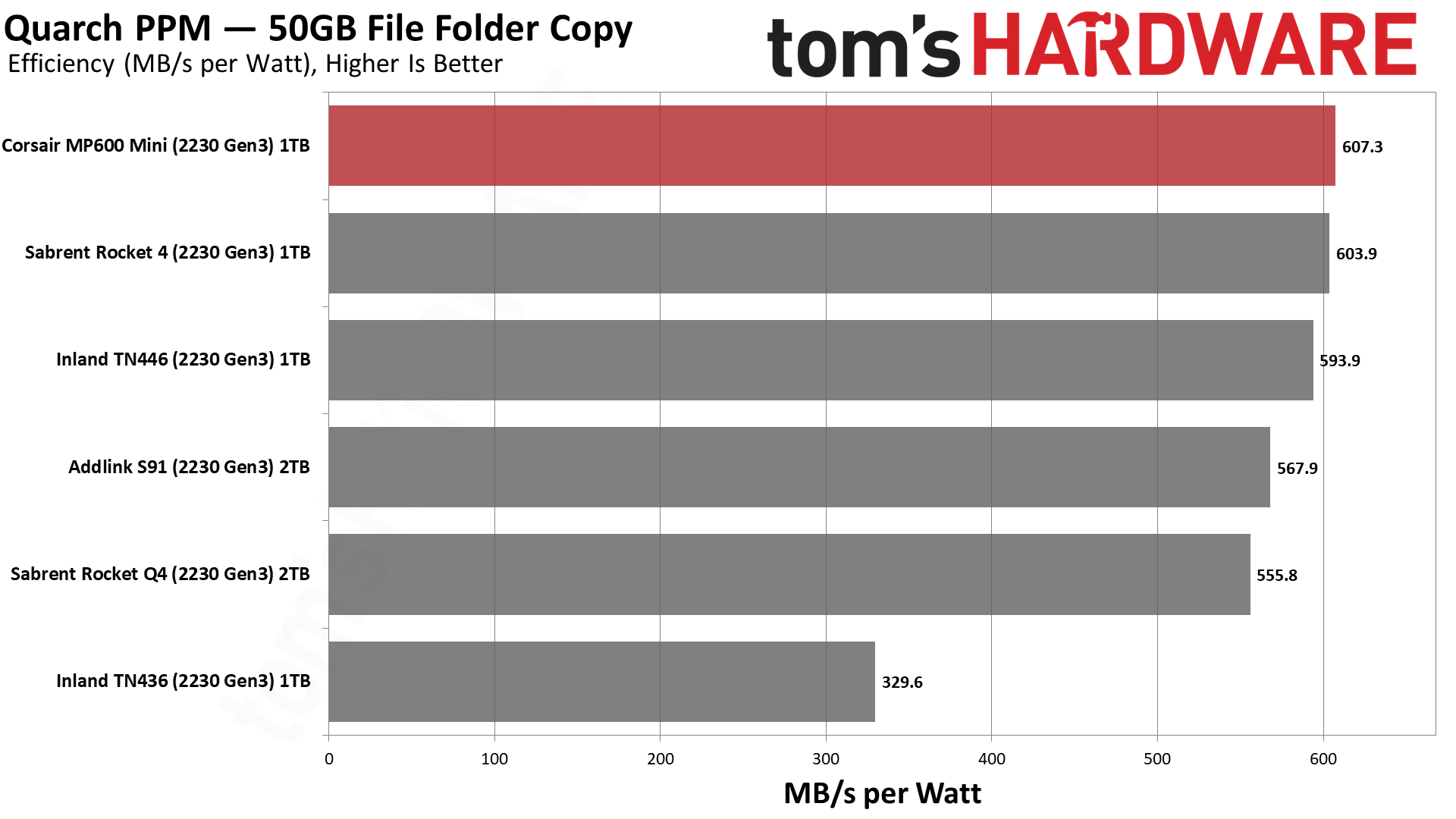
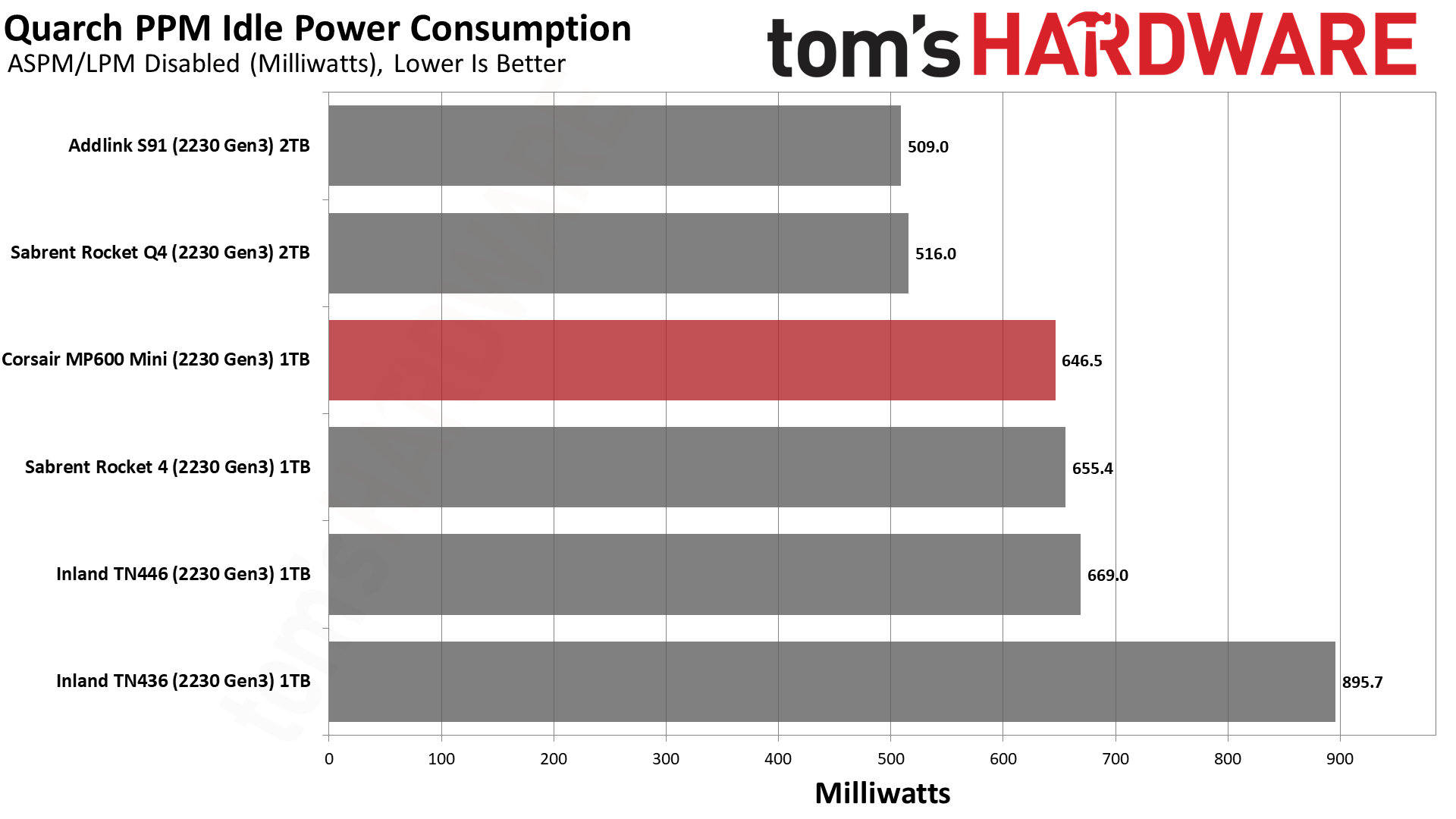
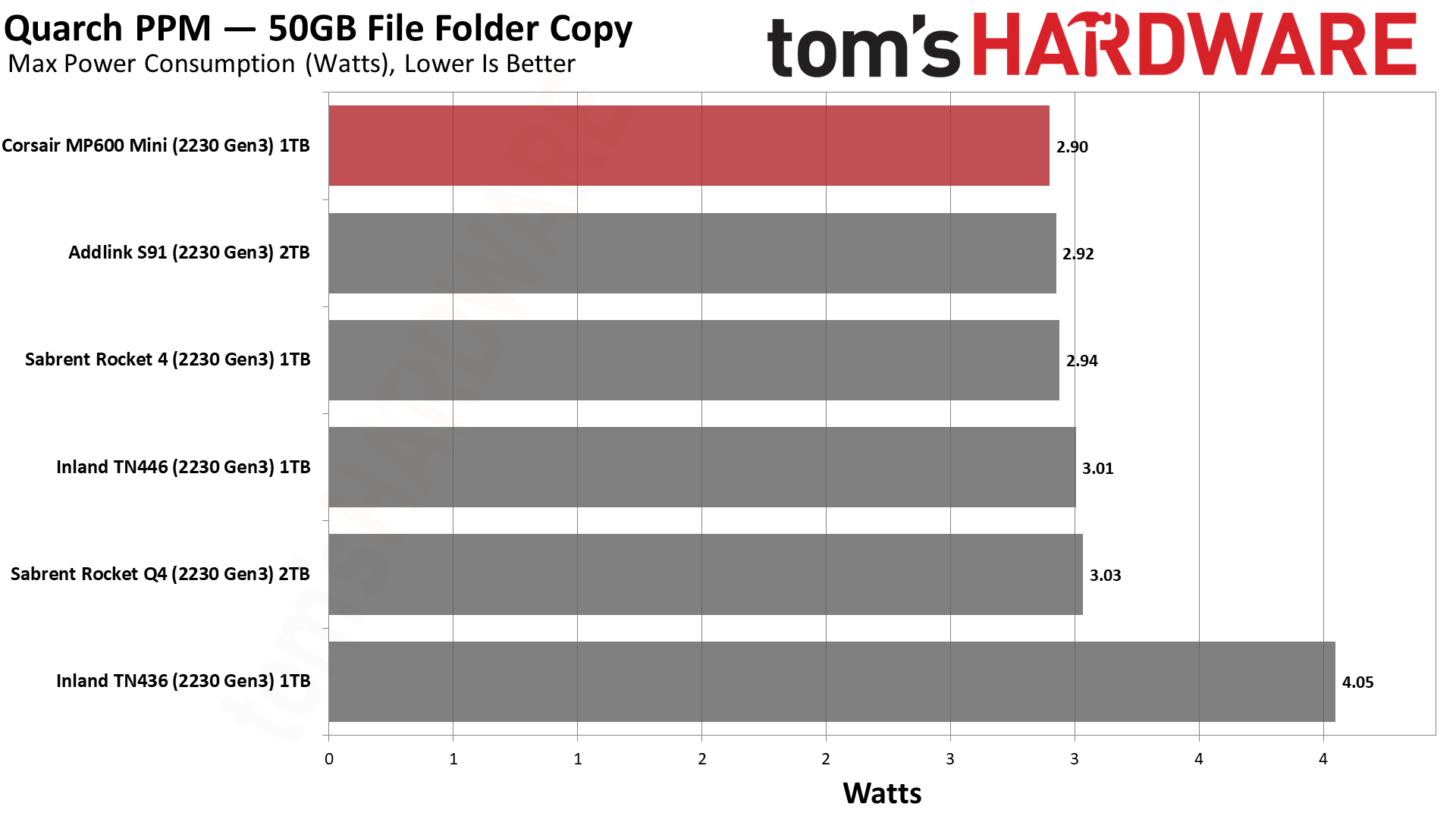
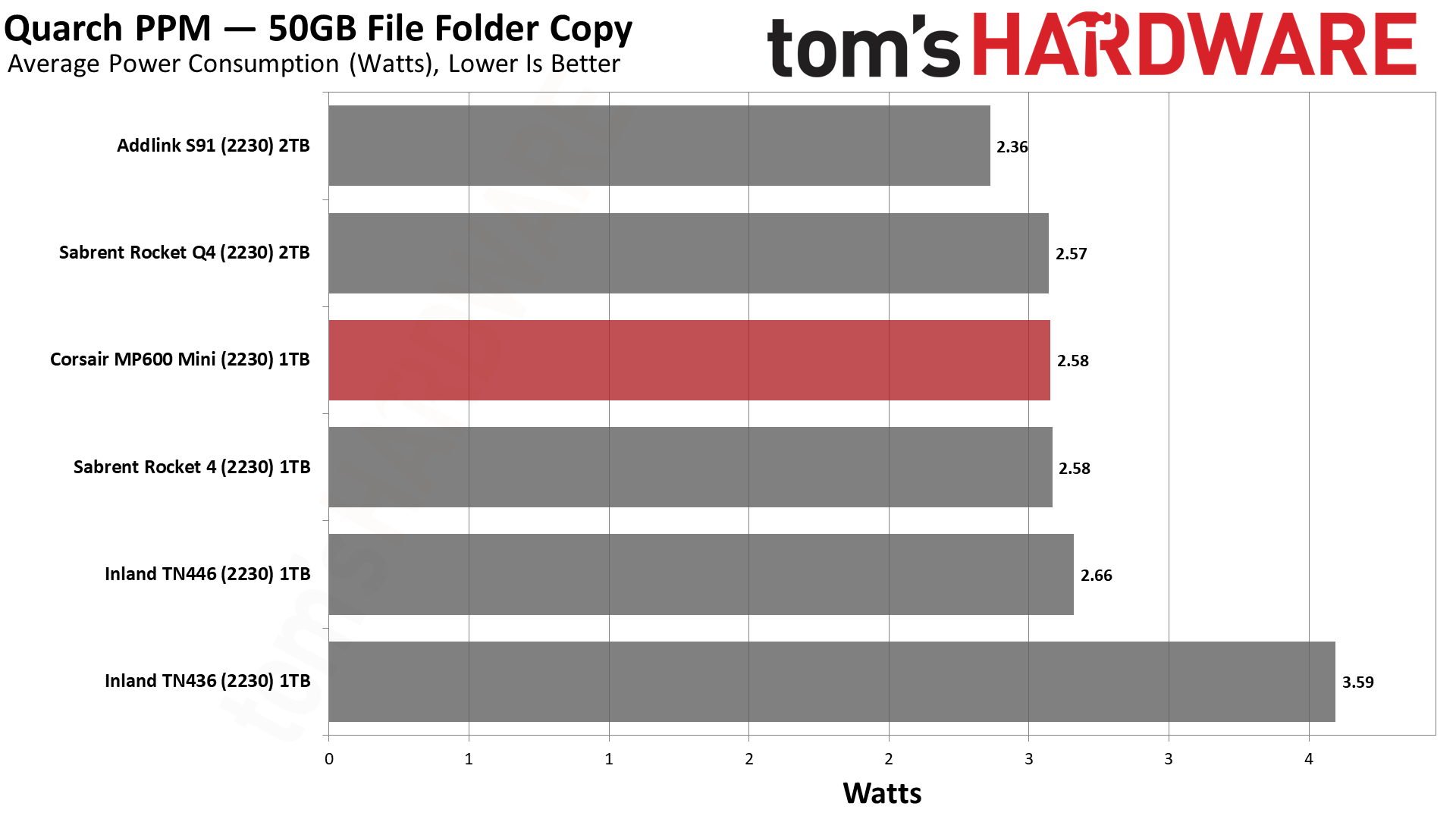


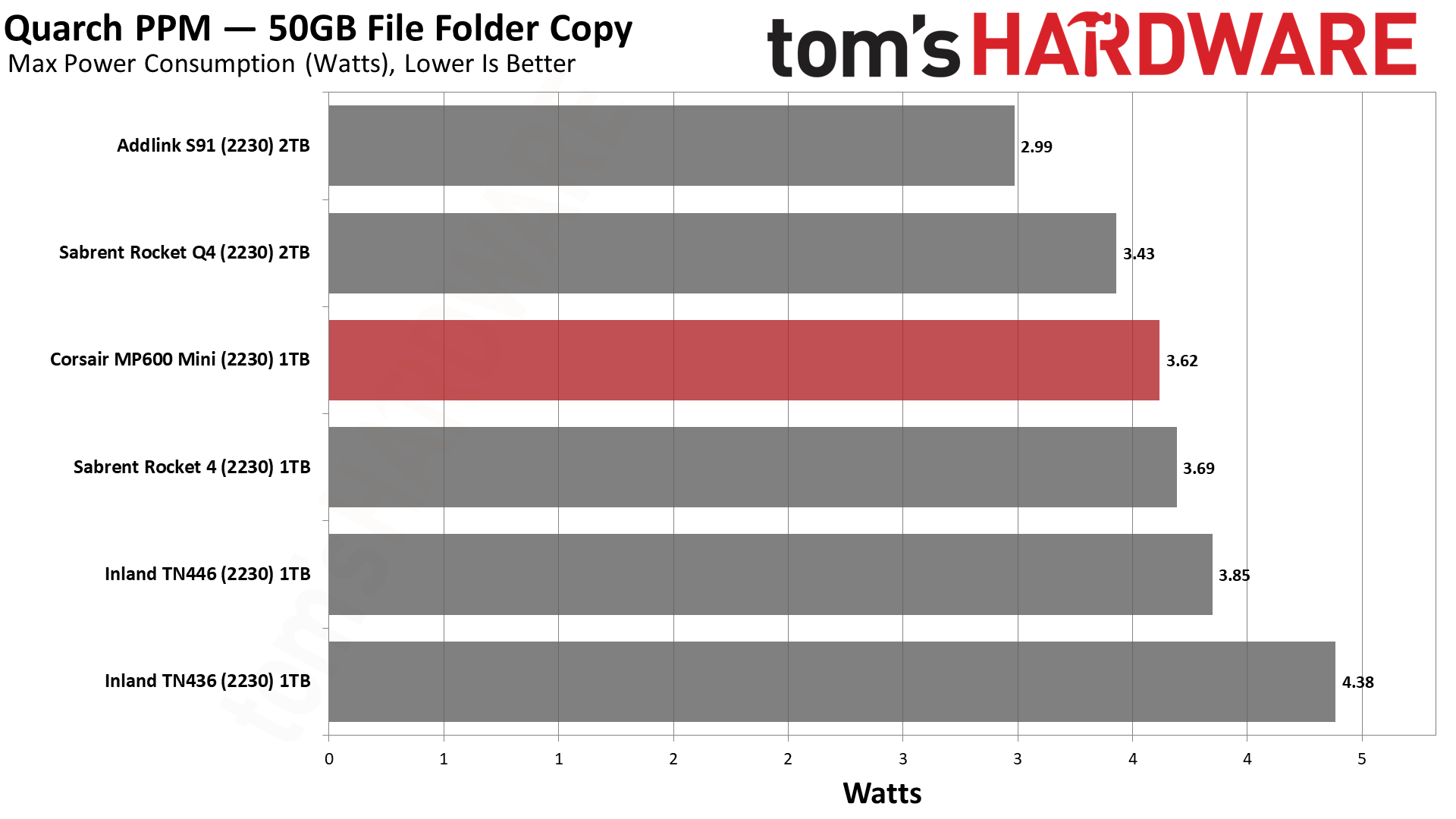
The MP600 Mini is the most efficient M.2 2230 SSD that we’ve tested to date. It manages to edge out the Rocket 2230 and TN446, with the QLC drives further behind. The older TN436 is in another zip code.
In normal testing, the MP600 Mini topped out at around 53C. You would have to engage in sustained writes to get it up towards throttling temperatures around 80C. The drive does run slightly cooler on average in PCIe 3.0 mode, but it’s likely to be hot in both the Steam Deck and ROG Ally due to their tight environments. There is a valid link between power draw and heat dissipation, and while this hardware is fast, the peak power draw is still quite reasonable.
Test Bench and Testing Notes
| CPU | Intel Core i9-12900K |
| Motherboard | Asus ROG Maximus Z790 Hero |
| Memory | 2x16GB G.Skill DDR5-5600 CL28 |
| Graphics | Intel Iris Xe UHD Graphics 770 |
| CPU Cooling | Enermax Aquafusion 240 |
| Case | Cooler Master TD500 Mesh V2 |
| Power Supply | Cooler Master V850 i Gold |
| OS Storage | Sabrent Rocket 4 Plus 2TB |
| Operating System | Windows 11 Pro |
We use an Alder Lake platform with most background applications such as indexing, Windows updates, and anti-virus disabled in the OS to reduce run-to-run variability. Each SSD is prefilled to 50% capacity and tested as a secondary device. Unless noted, we use active cooling for all SSDs.
Conclusion
We have nothing bad to say about the MP600 Mini, except maybe that we’d like to see more. 1TB is the most popular capacity for an M.2 2230 upgrade, particularly on the Steam Deck, so it makes sense that Corsair focused on hitting that point. TLC works well at that capacity for maximum performance, and this hardware is quite efficient, to boot. Currently, Corsair can sell this drive at a lower price than the competition, so this strategy works well. If you need 256GB, we recommend the Rocket 2230; at 512GB, we recommend the TN446, and at 2TB, the Rocket Q4 2230 or S91.
Many other options are on the market, including the Solidigm P41 Plus, the WD SN740, and the Micron 2400. These are all technically OEM drives. We would expect none to be as efficient as the drives based on the Phison E21T with Micron flash, whether TLC or QLC. However, they are all viable options if you can get them at a lower price. On the other hand, we would recommend against older drives, including the TN436 and other Kioxia BG5 clones. Generically-branded drives may or may not have newer hardware, but support will likely be limited for them anyway, so they should be considered a last resort - especially if you’re buying from a marketplace like AliExpress.
All in all, the MP600 Mini is a solid all-around drive. You can buy it without worry. It’s easy to get, and it’s priced right. Corsair knew what they were doing when they targeted this drive, although we would like to see even more options in this space.
MORE: Best SSDs
MORE: Best External SSDs and Hard Drives
MORE: How We Test HDDs And SSDs
MORE: All SSD Content

Shane Downing is a Freelance Reviewer for Tom’s Hardware US, covering consumer storage hardware.
-
Sleepy_Hollowed This is a great option for smaller builds to be honest, I'd jump on the chance to get one.Reply -
newtechldtech ReplySleepy_Hollowed said:This is a great option for smaller builds to be honest, I'd jump on the chance to get one.
??? all motherboards support full size M2 SSD , and this will not help the pc getting any smaller .
